For the past seven years, a malware-based proxy service known as “Faceless” has sold anonymity to countless cybercriminals. For less than a dollar per day, Faceless customers can route their malicious traffic through tens of thousands of compromised systems advertised on the service. In this post we’ll examine clues left behind over the past decade by the proprietor of Faceless, including some that may help put a face to the name.
Riley Kilmer is co-founder of Spur.us, a company that tracks thousands of VPN and proxy networks, and helps customers identify traffic coming through these anonymity services. Kilmer said Faceless has emerged as one of the underground’s most reliable malware-based proxy services, mainly because its proxy network has traditionally included a great many compromised “Internet of Things” devices — such as media sharing servers — that are seldom included on malware or spam block lists.
Kilmer said when Spur first started looking into Faceless, they noticed almost every Internet address that Faceless advertised for rent also showed up in the IoT search engine Shodan.io as a media sharing device on a local network that was somehow exposed to the Internet.
“We could reliably look up the [fingerprint] for these media sharing devices in Shodan and find those same systems for sale on Faceless,” Kilmer said.
In January 2023, the Faceless service website said it was willing to pay for information about previously undocumented security vulnerabilities in IoT devices. Those with IoT zero-days could expect payment if their exploit involved at least 5,000 systems that could be identified through Shodan.
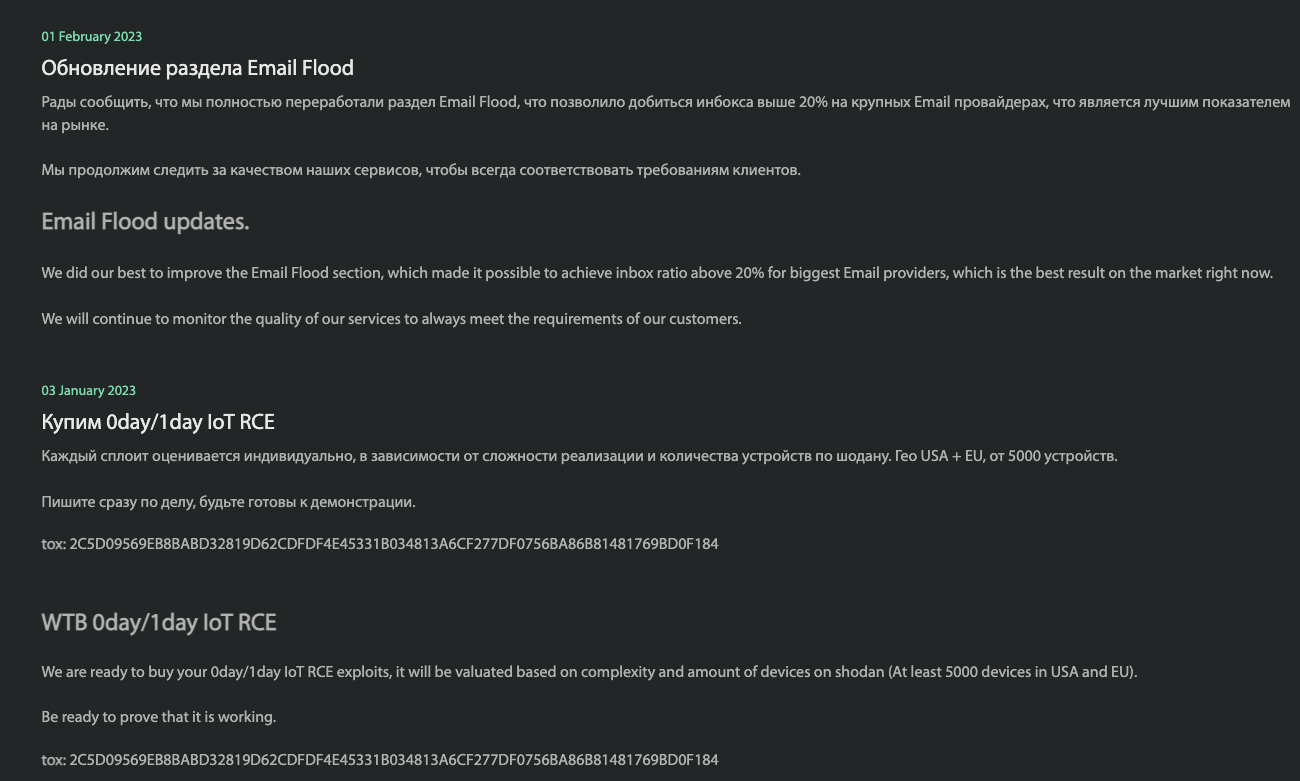
Notices posted for Faceless users, advertising an email flooding service and soliciting zero-day vulnerabilities in Internet of Things devices.
Recently, Faceless has shown ambitions beyond just selling access to poorly-secured IoT devices. In February, Faceless re-launched a service that lets users drop an email bomb on someone — causing the target’s inbox to be filled with tens of thousands of junk messages.
And in March 2023, Faceless started marketing a service for looking up Social Security Numbers (SSNs) that claims to provide access to “the largest SSN database on the market with a very high hit rate.”
Kilmer said Faceless wants to become a one-stop-fraud-shop for cybercriminals who are seeking stolen or synthetic identities from which to transact online, and a temporary proxy that is geographically close to the identity being sold. Faceless currently sells this bundled product for $9 — $8 for the identity and $1 for the proxy.
“They’re trying to be this one-stop shop for anonymity and personas,” Kilmer said. “The service basically says ‘here’s an SSN and proxy connection that should correspond to that user’s location and make sense to different websites.'”
Faceless is a project from MrMurza, a particularly talkative member of more than a dozen Russian-language cybercrime forums over the past decade. According to cyber intelligence firm Flashpoint, MrMurza has been active in the Russian underground since at least September 2012. Flashpoint said MrMurza appears to be extensively involved in botnet activity and “drops” — fraudulent bank accounts created using stolen identity data that are often used in money laundering and cash-out schemes.
Faceless grew out of a popular anonymity service called iSocks, which was launched in 2014 and advertised on multiple Russian crime forums as a proxy service that customers could use to route their malicious Web traffic through compromised computers.
Flashpoint says that in the months before iSocks went online, MrMurza posted on the Russian language crime forum Verified asking for a serious partner to assist in opening a proxy service, noting they had a botnet that was powered by malware that collected proxies with a 70 percent infection rate.

MrMurza’s Faceless advertised on the Russian-language cybercrime forum ProCrd. Image: Darkbeast/Ke-la.com.
In September 2016, MrMurza sent a message to all iSocks users saying the service would soon be phased out in favor of Faceless, and that existing iSocks users could register at Faceless for free if they did so quickly — before Faceless began charging new users registration fees between $50 and $100.
Verified and other Russian language crime forums where MrMurza had a presence have been hacked over the years, with contact details and private messages leaked online. In a 2014 private message to the administrator of Verified explaining his bona fides, MrMurza said he received years of positive feedback as a seller of stolen Italian credit cards and a vendor of drops services.
MrMurza told the Verified admin that he used the nickname AccessApproved on multiple other forums over the years. MrMurza also told the admin that his account number at the now-defunct virtual currency Liberty Reserve was U1018928.
According to cyber intelligence firm Intel 471, the user AccessApproved joined the Russian crime forum Zloy in Jan. 2012, from an Internet address in Magnitogorsk, RU. In a 2012 private message where AccessApproved was arguing with another cybercriminal over a deal gone bad, AccessApproved asked to be paid at the Liberty Reserve address U1018928.
In 2013, U.S. federal investigators seized Liberty Reserve and charged its founders with facilitating billions of dollars in money laundering tied to cybercrime. The Liberty Reserve case was prosecuted out of the Southern District of New York, which in 2016 published a list of account information (PDF) tied to thousands of Liberty Reserve addresses the government asserts were involved in money laundering.
That document indicates the Liberty Reserve account claimed by MrMurza/AccessApproved — U1018928 — was assigned in 2011 to a “Vadim Panov” who used the email address lesstroy@mgn.ru.
Constella Intelligence, a threat intelligence firm that tracks breached databases, says lesstroy@mgn.ru was used for an account “Hackerok” at the accounting service klerk.ru that was created from an Internet address in Magnitogorsk. The password chosen by this user was “1232.”
In addition to selling access to hacked computers and bank accounts, both MrMurza and AccessApproved ran side hustles on the crime forums selling clothing from popular retailers that refused to ship directly to Russia.
On one cybercrime forum where AccessApproved had clothing customers, denizens of the forum created a lengthy discussion thread to help users identify incoming emails associated with various reshipping services advertised within their community. Reshippers tend to rely on a large number of people in the United States and Europe helping to forward packages overseas, but in many cases the notifications about purchases and shipping details would be forwarded to reshipping service customers from a consistent email account.
That thread said AccessApproved’s clothing reshipping service forwarded confirmation emails from the address panov-v@mail.ru. This address is associated with accounts on two Russian cybercrime forums registered from Magnitogorsk in 2010 using the handle “Omega^gg4u.”
This Omega^gg4u identity sold software that can rapidly check the validity of large batches of stolen credit cards. Interestingly, both Omega^gg4u and AccessApproved also had another niche: Reselling heavily controlled substances — such as human growth hormone and anabolic steroids — from chemical suppliers in China.
A search in Constella on the address panov-v@mail.ru and many variations on that address shows these accounts cycled through the same passwords, including 055752403k, asus666, 01091987h, and the relatively weak password 1232 (recall that 1232 was picked by whoever registered the lesstroy@mgn.ru account at Klerk.ru).
Constella says the email address asus666@yandex.ru relied on the passwords asus666 and 01091987h. The 01091987h password also was used by asus666@mail.ru, which also favored the password 24587256.
Constella further reports that whoever owned the much shorter address asus@mail.ru also used the password 24587256. In addition, it found the password 2318922479 was tied to both asus666@mail.ru and asus@mail.ru.
The email addresses asus@mail.ru, asus2504@mail.ru, and zaxar2504@rambler.ru were all used to register Vkontakte social media accounts for a Denis ***@VIP*** Pankov. There are a number of other Vkontakte accounts registered to asus@mail.ru and many variations of this address under a different name. But none of those other profiles appear tied to real-life identities.
Constella’s data shows the email addresses asus2504@mail.ru and zaxar2504@rambler.ru used the rather unique password denis250485, which was also used by the email address denispankov@yandex.ru and almost a dozen variations at other Russian-language email providers.
Russian vehicle registration records from 2016 show the email address denispankov@yandex.ru belongs to Denis Viktorovich Pankov, born on April 25, 1985. That explains the “250485” portion of Pankov’s favored password. The registration records further indicate that in 2016 Pankov’s vehicle was registered in a suburb of Moscow.
Russian incorporation records show that denispankov@yandex.com is tied to IP Pankov Denis Viktorovich, a now-defunct transportation company in the Volograd Oblast, a region in southern Russia that shares a long border with western Kazazkhstan.
More recent records for IP Pankov Denis Viktorovich show a microenterprise with this name in Omsk that described its main activity as “retail sale by mail or via the Internet.” Russian corporate records indicate this entity was liquidated in 2021.
A reverse password search on “denis250485” via Constella shows this password was used by more than 75 email addresses, most of which are some variation of gaihnik@mail.ru — such as gaihnik25@mail.ru, or gaihnik2504@rambler.ru.
In 2012, someone posted answers to a questionnaire on behalf of Denis Viktorovich Pankov to a Russian-language discussion forum on Chinese crested dog breeds. The message said Pankov was seeking a puppy of a specific breed and was a resident of Krasnogorsk, a city that is adjacent to the northwestern boundary of Moscow.
The message said Pankov was a then 27-year-old manager in an advertising company, and could be reached at the email address gaihnik@mail.ru.
Constella Intelligence shows gaihnik@mail.ru registered at the now-defunct email marketing service Smart Responder from an address in Gagarin, which is about 115 miles west of Moscow.
Back in 2015, the user Gaihnik25 was banned from the online game World of Tanks for violating the game’s terms that prohibit “bot farming,” or the automated use of large numbers of player accounts to win some advantage that is usually related to cashing out game accounts or inventory.
For the past few years, someone using the nickname Gaihnik25 has been posting messages to the Russian-language hacking forum Gerki[.]pw, on discussion threads regarding software designed to “brute force” or mass-check online accounts for weak or compromised passwords.
A new member of the Russian hacking forum Nohide[.]Space using the handle Gaihnik has been commenting recently about proxy services, credential checking software, and the sale of hacked mailing lists. Gaihnik’s first post on the forum concerned private software for checking World of Tanks accounts.
The address gaihnik@mail.ru shows how so many email addresses tied to Pankov were also connected to apparently misleading identities on Vkontakte and elsewhere. Constella found this address was tied to a Vkontakte account for a Dmitriy Zakarov.
Microsoft’s Bing search engine says gaihnik@mail.ru belongs to 37-year-old Denis Pankov, yet clicking the Mail.ru profile for that user brings up a profile for a much older man by the name Gavril Zakarov. However, when you log in to a Mail.ru account and view that profile, it shows that most of the account’s profile photos are of a much younger man.
Many of those same photos show up in an online dating profile at dating.ru for the user Gaihnik, a.k.a “Denchik,” who says he is a 37-year-old Taurus from Gagarin who enjoys going for walks in nature, staying up late, and being on the Internet.
Mr. Pankov did not respond to multiple requests for comment sent to all of the email addresses mentioned in this story. However, some of those addresses produced detailed error responses; Mail.ru reported that the users panov-v@mail.ru, asus666@mail.ru, and asus2504@mail.ru were terminated, and that gaihnik25@mail.ru is now disabled.
Messages sent to many other email addresses connected via passwords to Pankov and using some variation of asus####@mail.ru also returned similar account termination messages.

KrebsOnSecurity received a nice bump in traffic this week thanks to tweets from the Federal Bureau of Investigation (FBI) and the Federal Communications Commission (FCC) about “juice jacking,” a term first coined here in 2011 to describe a potential threat of data theft when one plugs their mobile device into a public charging kiosk. It remains unclear what may have prompted the alerts, but the good news is that there are some fairly basic things you can do to avoid having to worry about juice jacking.
On April 6, 2023, the FBI’s Denver office issued a warning about juice jacking in a tweet.
“Avoid using free charging stations in airports, hotels or shopping centers,” the FBI’s Denver office warned. “Bad actors have figured out ways to use public USB ports to introduce malware and monitoring software onto devices. Carry your own charger and USB cord and use an electrical outlet instead.”
Five days later, the Federal Communications Commission (FCC) issued a similar warning. “Think twice before using public charging stations,” the FCC tweeted. “Hackers could be waiting to gain access to your personal information by installing malware and monitoring software to your devices. This scam is referred to as juice jacking.”
The FCC tweet also provided a link to the agency’s awareness page on juice jacking, which was originally published in advance of the Thanksgiving Holiday in 2019 but was updated in 2021 and then again shortly after the FBI’s tweet was picked up by the news media. The alerts were so broadly and breathlessly covered in the press that a mention of juice jacking even made it into this week’s Late Late Show with James Corden.
The term juice jacking crept into the collective paranoia of gadget geeks in the summer of 2011, thanks to the headline for a story here about researchers at the DEFCON hacker convention in Vegas who’d set up a mobile charging station designed to educate the unwary to the reality that many mobile devices connected to a computer would sync their data by default.
Since then, Apple, Google and other mobile device makers have changed the way their hardware and software works so that their devices no longer automatically sync data when one plugs them into a computer with a USB charging cable. Instead, users are presented with a prompt asking if they wish to trust a connected computer before any data transfer can take place.
On the other hand, the technology needed to conduct a sneaky juice jacking attack has become far more miniaturized, accessible and cheap. And there are now several products anyone can buy that are custom-built to enable juice jacking attacks.
Probably the best known example is the OMG cable, a $180 hacking device made for professional penetration testers that looks more or less like an Apple or generic USB charging cable. But inside the OMG cable is a tiny memory chip and a Wi-Fi transmitter that creates a Wi-Fi hotspot, to which the attacker can remotely connect using a smartphone app and run commands on the device.
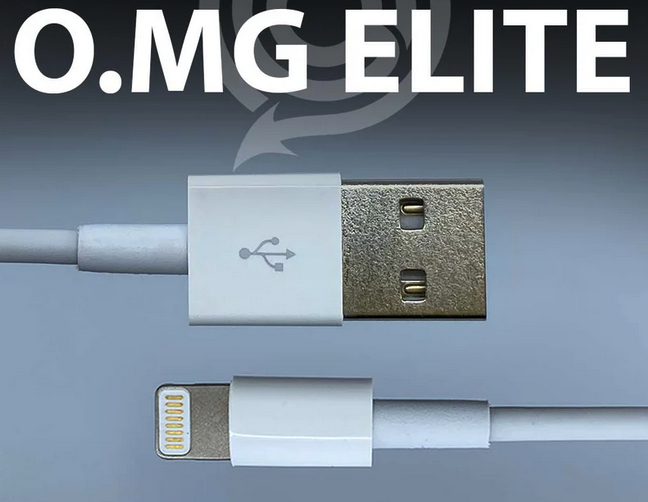
The $180 “OMG cable.” Image: hak5.org.
Brian Markus is co-founder of Aries Security, and one of the researchers who originally showcased the threat from juice jacking at the 2011 DEFCON. Markus said he isn’t aware of any public accounts of juice jacking kiosks being found in the wild, and said he’s unsure what prompted the recent FBI alert.
But Markus said juice jacking is still a risk because it is far easier and cheaper these days for would-be attackers to source and build the necessary equipment.
“Since then, the technology and components have become much smaller and very easy to build, which puts this in the hands of less sophisticated threat actors,” Markus said. “Also, you can now buy all this stuff over the counter. I think the risk is possibly higher now than it was a decade ago, because a much larger population of people can now pull this off easily.”
How seriously should we take the recent FBI warning? An investigation by the myth-busting site Snopes suggests the FBI tweet was just a public service announcement based on a dated advisory. Snopes reached out to both the FBI and the FCC to request data about how widespread the threat of juice jacking is in 2023.
“The FBI replied that its tweet was a ‘standard PSA-type post’ that stemmed from the FCC warning,” Snopes reported. “An FCC spokesperson told Snopes that the commission wanted to make sure that their advisory on “juice-jacking,” first issued in 2019 and later updated in 2021, was up-to-date so as to ensure ‘the consumers have the most up-to-date information.’ The official, who requested anonymity, added that they had not seen any rise in instances of consumer complaints about juice-jacking.”
What can you do to avoid juice jacking? Bring your own gear. A general rule of thumb in security is that if an adversary has physical access to your device, you can no longer trust the security or integrity of that device. This also goes for things that plug into your devices.
Juice jacking isn’t possible if a device is charged via a trusted AC adapter, battery backup device, or through a USB cable with only power wires and no data wires present. If you lack these things in a bind and still need to use a public charging kiosk or random computer, at least power your device off before plugging it in.
Microsoft today released software updates to plug 100 security holes in its Windows operating systems and other software, including a zero-day vulnerability that is already being used in active attacks. Not to be outdone, Apple has released a set of important updates addressing two zero-day vulnerabilities that are being used to attack iPhones, iPads and Macs.

On April 7, Apple issued emergency security updates to fix two weaknesses that are being actively exploited, including CVE-2023-28206, which can be exploited by apps to seize control over a device. CVE-2023-28205 can be used by a malicious or hacked website to install code.
Both vulnerabilities are addressed in iOS/iPadOS 16.4.1, iOS 15.7.5, and macOS 12.6.5 and 11.7.6. If you use Apple devices and you don’t have automatic updates enabled (they are on by default), you should probably take care of that soon as detailed instructions on how to attack CVE-2023-28206 are now public.
Microsoft’s bevy of 100 security updates released today include CVE-2023-28252, which is a weakness in Windows that Redmond says is under active attack. The vulnerability is in the Windows Common Log System File System (CLFS) driver, a core Windows component that was the source of attacks targeting a different zero-day vulnerability in February 2023.
“If it seems familiar, that’s because there was a similar 0-day patched in the same component just two months ago,” said Dustin Childs at the Trend Micro Zero Day Initiative. “To me, that implies the original fix was insufficient and attackers have found a method to bypass that fix. As in February, there is no information about how widespread these attacks may be. This type of exploit is typically paired with a code execution bug to spread malware or ransomware.”
According to the security firm Qualys, this vulnerability has been leveraged by cyber criminals to deploy Nokoyawa ransomware.
“This is a relatively new strain for which there is some open source intel to suggest that it is possibly related to Hive ransomware – one of the most notable ransomware families of 2021 and linked to breaches of over 300+ organizations in a matter of just a few months,” said Bharat Jogi, director of vulnerability and threat research at Qualys.
Jogi said while it is still unclear which exact threat actor is targeting CVE-2023-28252, targets have been observed in South and North America, regions across Asia and at organizations in the Middle East.
Satnam Narang at Tenable notes that CVE-2023-28252 is also the second CLFS zero-day disclosed to Microsoft by researchers from Mandiant and DBAPPSecurity (CVE-2022-37969), though it is unclear if both of these discoveries are related to the same attacker.
Seven of the 100 vulnerabilities Microsoft fixed today are rated “Critical,” meaning they can be used to install malicious code with no help from the user. Ninety of the flaws earned Redmond’s slightly less-dire “Important” label, which refers to weaknesses that can be used to undermine the security of the system but which may require some amount of user interaction.
Narang said Microsoft has rated nearly 90% of this month’s vulnerabilities as “Exploitation Less Likely,” while just 9.3% of flaws were rated as “Exploitation More Likely.” Kevin Breen at Immersive Labs zeroed in on several notable flaws in that 9.3%, including CVE-2023-28231, a remote code execution vulnerability in a core Windows network process (DHCP) with a CVSS score of 8.8.
“‘Exploitation more likely’ means it’s not being actively exploited but adversaries may look to try and weaponize this one,” Breen said. “Micorosft does note that successful exploitation requires an attacker to have already gained initial access to the network. This could be via social engineering, spear phishing attacks, or exploitation of other services.”
Breen also called attention to CVE-2023-28220 and CVE-2023-28219 — a pair of remote code execution vulnerabilities affecting Windows Remote Access Servers (RAS) that also earned Microsoft’s “exploitation more likely” label.
“An attacker can exploit this vulnerability by sending a specially crafted connection request to a RAS server, which could lead to remote code execution,” Breen said. While not standard in all organizations, RAS servers typically have direct access from the Internet where most users and services are connected. This makes it extremely enticing for attackers as they don’t need to socially engineer their way into an organization. They can simply scan the internet for RAS servers and automate the exploitation of vulnerable devices.”
For more details on the updates released today, see the SANS Internet Storm Center roundup. If today’s updates cause any stability or usability issues in Windows, AskWoody.com will likely have the lowdown on that.
Please consider backing up your data and/or imaging your system before applying any updates. And feel free to sound off in the comments if you experience any problems as a result of these patches.
Several domain names tied to Genesis Market, a bustling cybercrime store that sold access to passwords and other data stolen from millions of computers infected with malicious software, were seized by the Federal Bureau of Investigation (FBI) today. The domain seizures coincided with more than a hundred arrests in the United States and abroad targeting those who allegedly operated the service, as well as suppliers who continuously fed Genesis Market with freshly-stolen data.

Several websites tied to the cybercrime store Genesis Market had their homepages changed today to this seizure notice.
Active since 2018, Genesis Market’s slogan was, “Our store sells bots with logs, cookies, and their real fingerprints.” Customers could search for infected systems with a variety of options, including by Internet address or by specific domain names associated with stolen credentials.
But earlier today, multiple domains associated with Genesis had their homepages replaced with a seizure notice from the FBI, which said the domains were seized pursuant to a warrant issued by the U.S. District Court for the Eastern District of Wisconsin.
The U.S. Attorney’s Office for the Eastern District of Wisconsin did not respond to requests for comment. The FBI declined to comment.
Update, April 5, 11:40 a.m. ET: The U.S. Department of Justice just released a statement on its investigation into Genesis Market. In a press briefing this morning, FBI and DOJ officials said the international law enforcement investigation involved 14 countries and resulted in 400 law enforcement actions, including 119 arrests and 208 searches and interviews worldwide. The FBI confirmed that some American suspects are among those arrested, although officials declined to share more details on the arrests.
The DOJ said investigators were able to access the user database for Genesis Market, and found the invite-only service had more than 59,000 registered users. The database contained the purchase and activity history on all users, which the feds say helped them uncover the true identities of many users.
Original story: But sources close to the investigation tell KrebsOnSecurity that law enforcement agencies in the United States, Canada and across Europe are currently serving arrest warrants on dozens of individuals thought to support Genesis, either by maintaining the site or selling the service bot logs from infected systems.
The seizure notice includes the seals of law enforcement entities from several countries, including Australia, Canada, Denmark, Germany, the Netherlands, Spain, Sweden and the United Kingdom.
When Genesis customers purchase a bot, they’re purchasing the ability to have all of the victim’s authentication cookies loaded into their browser, so that online accounts belonging to that victim can be accessed without the need of a password, and in some cases without multi-factor authentication.
“You can buy a bot with a real fingerprint, access to e-mail, social networks, bank accounts, payment systems!,” a cybercrime forum ad for Genesis enthused. “You also get all previous digital life (history) of the bot – most services won’t even ask for login and password and identify you as their returning customer. Purchasing a bot kit with the fingerprint, cookies and accesses, you become the unique user of all his or her services and other web-sites. The other use of our kit of real fingerprints is to cover-up the traces of your real internet activity.”
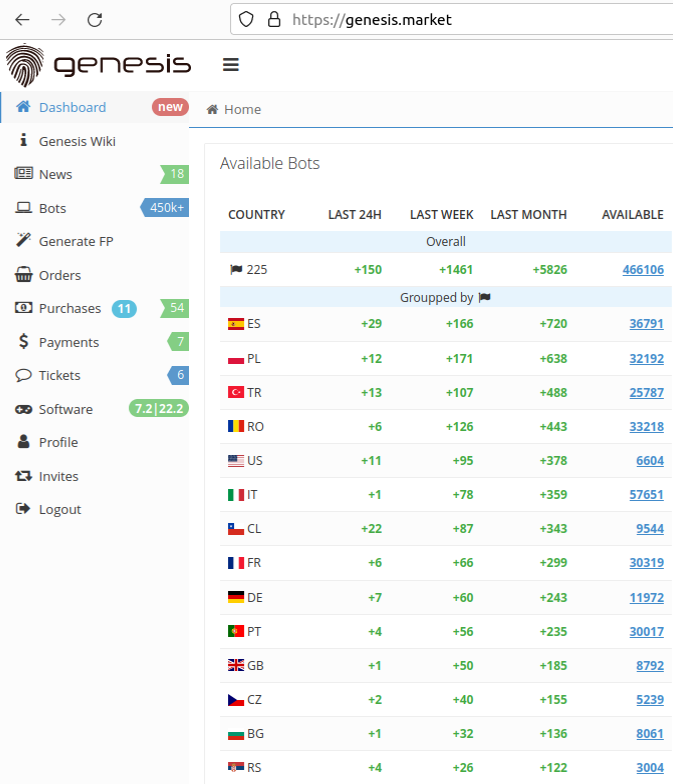
The Genesis Store had more than 450,000 bots for sale as of Mar. 21, 2023. Image: KrebsOnSecurity.
The pricing for Genesis bots ranged quite a bit, but in general bots with large amounts of passwords and authentication cookies — or those with access to specific financial websites such as PayPal and Coinbase — tended to fetch far higher prices.
New York based cyber intelligence firm Flashpoint says that in addition to containing a large number of resources, the most expensive bots overwhelmingly seem to have access to accounts that are easy to monetize.
“The high incidence of Google and Facebook is expected, as they are such widely used platforms,” Flashpoint noted in an analysis of Genesis Market, observing that all ten of the ten most expensive bots at the time included Coinbase credentials.
Genesis Market has introduced a number of cybercriminal innovations throughout its existence. Probably the best example is Genesis Security, a custom Web browser plugin which can load a Genesis bot profile so that the browser mimics virtually every important aspect of the victim’s device, from screen size and refresh rate to the unique user agent string tied to the victim’s web browser.
Flashpoint said the administrators of Genesis Market claim they are a team of specialists with “extensive experience in the field of systems metrics.” They say they developed the Genesis Security software by analyzing the top forty-seven browser fingerprinting and tracking systems, as well as those utilized by 283 different banking and payment systems.
Cybersecurity experts say Genesis and a handful of other bot shops are also popular among cybercriminals who work to identify and purchase bots inside corporate networks, and then turn around and resell that access to ransomware gangs.
Michael Debolt, chief intelligence officer for Intel 471, said so-called “network access brokers” will scour automated bot shops for high value targets, and then resell them for a bigger profit.
“From ‘used’ or ‘processed’ logs — it is actually quite common for the same log to be used by multiple different actors who are all using it for different purposes – for instance, some actors are only interested in crypto wallet or banking credentials so they bypass credentials that network access brokers are interested in,” Debolt said. “These network access brokers buy these ‘used’ logs for very cheap (or sometimes for free) and search for big fish targets from there.”
In June 2021, hackers who broke into and stole a wealth of source code and game data from the computer gaming giant EA told Motherboard they gained access by purchasing a $10 bot from Genesis Market that let them log into a company Slack account.
One feature of Genesis that sets it apart from other bot shops is that customers can retain access to infected systems in real-time, so that if the rightful owner of an infected system creates a new account online, those new credentials will get stolen and displayed in the web-based panel of the Genesis customer who purchased that bot.
“While some infostealers are designed to remove themselves after execution, others create persistent access,” reads a March 2023 report from cybersecurity firm SpyCloud. “That means bad actors have access to the current data for as long as the device remains infected, even if the user changes passwords.”
SpyCloud says Genesis even advertises its commitment to keep the stolen data and the compromised systems’ fingerprints up to date.
“According to our research, Genesis Market had more than 430,000 stolen identities for sale as of early last year – and there are many other marketplaces like this one,” the SpyCloud report concludes.
It appears this week’s action targeted only the clear web versions of Genesis Market, and that the store is still operating on a dark web address that is only reachable through the Tor network. In today’s press briefing, DOJ officials said their investigation is ongoing, and that actions taken already have allowed them to disrupt Genesis in a way that may not be readily apparent.
In a blog post today, security firm Trellix said it was approached by the Dutch Police, who were seeking assistance with the analysis and detection of the malicious files linked to Genesis Market.
“The primary goal was to render the market’s scripts and binaries useless,” Trellix researchers wrote.
As described in the Trellix blog, a major part of this effort against Genesis Market involves targeting its suppliers, or cybercriminals who are constantly feeding the market with freshly-stolen bot data. The company says Genesis partnered with multiple cybercriminals responsible for selling, distributing and maintaining different strains of infostealer malware, including malware families such as Raccoon Stealer.
“Over the years, Genesis Market has worked with a large variety of malware families to infect victims, where their info stealing scripts were used to steal information, which was used to populate the Genesis Market store,” the Trellix researchers continued. “It comes as no surprise that the malware families linked to Genesis Market belong to the usual suspects of common info-stealers, like AZORult, Raccoon, Redline and DanaBot. In February 2023, Genesis Market started to actively recruit sellers. We believe with a moderate level of confidence that this was done to keep up with the growing demand of their users.”
How does one’s computer become a bot in one of these fraud networks? Infostealers are continuously mass-deployed via several methods, including malicious attachments in email; manipulating search engine results for popular software titles; and malware that is secretly attached to legitimate software made available for download via software crack websites and file-sharing networks.
John Fokker, head of threat intelligence at Trellix, told KrebsOnSecurity that the Dutch Police tracked down several people whose data was for sale on Genesis Market, and discovered that the victims had installed infostealer malware that was bundled with pirated software.
The Dutch Police have stood up a website that lets visitors check whether their information was part of the stolen data for sale on Genesis. Troy Hunt‘s Have I Been Pwned website is also offering a lookup service based on data seized by the FBI.
Ruben van Well, team leader of the Dutch police cybercrime unit in Rotterdam, said more than 800,000 visitors have already checked their website, and that more than 2,000 of those visitors were alerted to active infostealer malware infections.
Van Well said Dutch authorities executed at least 17 arrests in connection with the investigation so far. He added that while the cybercriminals running Genesis Market promised their customers that user account security was a high priority, the service stored all of its data in plain text.
“If users would say can you please delete my account, they’d do it, but we can still see in the logs that they asked for that,” van Well said. “Genesis Market was not very good at protecting the security of its users, which made a mess for them but it’s been great for law enforcement.”
According to the Dutch Police, Microsoft this morning shipped an update to supported Windows computers that can remove infections from infostealer malware families associated with Genesis Market.
The Dutch computer security firm Computest worked with Trellix and the Dutch Police to analyze the Genesis Market malware. Their highly technical deep-dive is available here.
This is a developing story. Any updates will be added with notice and timestamp here.
Apr. 5, 11:00 am ET: Added statement from Justice Department, and background from a press briefing this morning.
Apr. 5, 12:24 pm ET: Added perspective from Trellix, and context from DOJ officials.
Apr. 5, 1:27 pm ET: Added links to lookup services by the Dutch Police and Troy Hunt.
John Clifton Davies, a 60-year-old con man from the United Kingdom who fled the country in 2015 before being sentenced to 12 years in prison for fraud, has enjoyed a successful life abroad swindling technology startups by pretending to be a billionaire investor. Davies’ newest invention appears to be “CodesToYou,” which purports to be a “full cycle software development company” based in the U.K.

The scam artist John Bernard a.k.a. Alan John Mykailov (left) in a recent Zoom call, and a mugshot of John Clifton Davies from nearly a decade earlier.
Several articles here have delved into the history of John Bernard, the pseudonym used by a fake billionaire technology investor who tricked dozens of startups into giving him tens of millions of dollars.
John Bernard’s real name is John Clifton Davies, a convicted fraudster from the United Kingdom who is currently a fugitive from justice. For several years until reinventing himself again quite recently, Bernard pretended to be a billionaire Swiss investor who made his fortunes in the dot-com boom 20 years ago.
“The Private Office of John Bernard” let it be known to investment brokers that he had tens of millions of dollars to invest in tech startups, and he attracted a stream of new victims by offering extraordinarily generous finder’s fees to brokers who helped him secure new clients. But those brokers would eventually get stiffed because Bernard’s company would never consummate a deal.

John Bernard’s former website, where he pretended to be a billionaire tech investor.
Bernard would promise to invest millions in tech startups, and then insist that companies pay tens of thousands of dollars worth of due diligence fees up front. However, the due diligence company he insisted on using — another Swiss firm called The Inside Knowledge GmbH — also was secretly owned by Bernard, who would invariably pull out of the deal after receiving the due diligence money.
A variety of clues suggest Davies has recently adopted at least one other identity — Alan John Mykhailov — who is listed as chairman of a British concern called CodesToYou LTD, incorporated in May 2022. The CodesToYou website says the company employs talented coders in several countries, and that its programmers offer “your ultimate balance between speed, cost and quality.”

The team from CodesToYou.
In response to questions from KrebsOnSecurity, CodesToYou’s marketing manager — who gave their name only as “Zhena” — said the company was not affiliated with any John Bernard or John Clifton Davies, and maintained that CodesToYou is a legitimate enterprise.
But publicly available information about this company and its leadership suggests otherwise. Official incorporation documents from the U.K.’s Companies House represent that CodesToYou is headed by an Alan John Mykhailov, a British citizen born in March 1958.
Companies House says Mykhailov is an officer in three other companies, including one called Blackstone Corporate Alliance Ltd. According to the Swiss business tracking service business-monitor.ch, Blackstone Corporate Alliance Ltd. is currently the entity holding a decision-making role in John Bernard’s fake due diligence company — The Inside Knowledge GmbH — which is now in liquidation.

A screen shot of the stock photos and corporate-speak on John Bernard’s old website. Image: Archive.org
Also listed as a partner in Blackstone Corporate Alliance Limited is Igor Hubskyi (a.k.a. Igor Gubskyi), a Ukrainian man who was previously president of The Inside Knowledge GmbH.
The CodesToYou website says the company’s marketing team lead is Maria Yakovleva, and the photo of this employee matches the profile for the LinkedIn account name “Maria Y.” That same LinkedIn profile and photo previously listed Maria by a different first and last name — Mariya Kulikova; back then, Ms. Kulikova’s LinkedIn profile said she was an executive assistant in The Private Office of Mr. John Bernard.
Companies House lists Alan John Mykhailov as a current officer in two other companies, including Frisor Limited, and Ardelis Solutions Limited. A cached copy of the now-defunct Ardelis Solutions website says it was a private equity firm.
CodesToYou’s Maria also included Ardelis Solutions in the work history section of her LinkedIn resume. That is, until being contacted by this author on LinkedIn, after which Maria’s profile picture and any mention of Ardelis Solutions were deleted.
Listed as head of business development at CodesToYou is David Bruno, a Canadian man whose LinkedIn profile says he is founder of an organization called “World Privacy Resource.” As KrebsOnSecurity reported in 2020, Bruno was at the time promoting himself as the co-CEO of a company called SafeSwiss Secure Communication AG, and the founder of another tech startup called Secure Swiss Data.
Secure Swiss Data’s domain — secureswissdata.com — is a Swiss concern that sells encrypted email and data services. According to DomainTools.com, that website name was registered in 2015 by The Inside Knowledge GmbH. In February 2020, a press release announced that Secure Swiss Data was purchased in an “undisclosed multimillion buyout” by SafeSwiss Secure Communication AG.

A cached copy of the Ardelis Solutions website, which said it was a private equity firm and included similar stock images as John Bernard’s investment website.
When reached in 2020 and asked about his relationship to Mr. Bernard, Mr. Bruno said the two were business partners and that he couldn’t imagine that Mr. Bernard would be involved in anything improper. To this day Mr. Bruno is the only person I’ve spoken to who has had anything positive to say about Mr. Bernard.
Mr. Bruno did not respond to requests for comment this time around, but his LinkedIn profile no longer makes any mention of Secure Swiss Data or SafeSwiss — both companies he claimed to run for many years. Nor does it mention CodesToYou. However, Mr. Bruno’s former company SafeSwiss is listed as one of the six “portfolio” companies whose services are promoted on the CodesToYou website.
In mid-2021, Bruno announced he was running for public office in Ontario.
“The Kenora resident is no stranger to the government as he contributed to Canada’s new Digital Charter, Bill C-11, which is a new Cyber Security policy,” reported Drydennow.com, a news website that covers Northwestern Ontario. Drydennow says the next federal election is expected to be held on or before Oct. 16, 2023.
John Clifton Davies was convicted in 2015 of swindling businesses throughout the U.K. that were struggling financially and seeking to restructure their debt. For roughly six years, Davies ran a series of firms that pretended to offer insolvency services, but instead simply siphoned what little remaining money these companies had.
The very first entity mentioned in the technology portfolio advertised on the CodesToYou website is called “MySolve,” and it purports to offer a “multi-feature platform for insolvency practitioners.”
Mr. Davies’ fourth wife, Iryna Davies, is listed as a director of one of the insolvency consulting businesses in the U.K. that was part of John Davies’ 2015 fraud conviction. Prior to his trial for fraud, Davies served 16 months in jail before being cleared of murdering his third wife on their honeymoon in India: Colette Davies, 39, died after falling 80 feet from a viewing point at a steep gorge in the Himachal Pradesh region of India.
Mr. Davies was charged with murder and fraud after he attempted to collect GBP 132,000 in her life insurance payout, but British prosecutors ultimately conceded they did not have enough evidence to convict him.
The scams favored by Davies and his alter egos are smart because he never approaches investors directly; rather, investors are incentivized to put his portfolio in front of tech firms seeking financial backing. And all the best cons begin as an idea or possibility planted in the target’s mind.
It’s also a reliable scam because companies bilked by small-time investment schemes rarely pursue legal action, mainly because the legal fees involved can quickly surpass the losses. On top of that, many victims will likely be too ashamed to admit their duping. Victims who do press their case in court and win then face the daunting challenge of collecting damages from a slew of ephemeral shell corporations.
The latest Bernard victim to speak publicly — a Norwegian company hoping to build a fleet of environmentally friendly shipping vessels — is now embroiled in a lawsuit over a deal gone bad. As part of that scam, Bernard falsely claimed to have secured $100 million from six other wealthy investors, including the founder of Uber and the artist Abel Makkonen Tesfaye, better known as The Weeknd.
If you liked this story, check out my previous reporting on John Bernard/Davies:
Due Diligence That Money Can’t Buy
Who is Tech Investor John Bernard?
Promising Infusions of Cash, Fake Investor John Bernard Walked Away With $30 Million
Investment Scammer John Davies Reinvents Himself?
Fake Investor John Bernard Sinks Norwegian Green Shipping Dreams








woo-1200

A new breach involving data from nine million AT&T customers is a fresh reminder that your mobile provider likely collects and shares a great deal of information about where you go and what you do with your mobile device — unless and until you affirmatively opt out of this data collection. Here’s a primer on why you might want to do that, and how.

Image: Shutterstock
Telecommunications giant AT&T disclosed this month that a breach at a marketing vendor exposed certain account information for nine million customers. AT&T said the data exposed did not include sensitive information, such as credit card or Social Security numbers, or account passwords, but was limited to “Customer Proprietary Network Information” (CPNI), such as the number of lines on an account.
Certain questions may be coming to mind right now, like “What the heck is CPNI?” And, ‘If it’s so ‘customer proprietary,’ why is AT&T sharing it with marketers?” Also maybe, “What can I do about it?” Read on for answers to all three questions.
AT&T’s disclosure said the information exposed included customer first name, wireless account number, wireless phone number and email address. In addition, a small percentage of customer records also exposed the rate plan name, past due amounts, monthly payment amounts and minutes used.
CPNI refers to customer-specific “metadata” about the account and account usage, and may include:
-Called phone numbers
-Time of calls
-Length of calls
-Cost and billing of calls
-Service features
-Premium services, such as directory call assistance
According to a succinct CPNI explainer at TechTarget, CPNI is private and protected information that cannot be used for advertising or marketing directly.
“An individual’s CPNI can be shared with other telecommunications providers for network operating reasons,” wrote TechTarget’s Gavin Wright. “So, when the individual first signs up for phone service, this information is automatically shared by the phone provider to partner companies.”
Is your mobile Internet usage covered by CPNI laws? That’s less clear, as the CPNI rules were established before mobile phones and wireless Internet access were common. TechTarget’s CPNI primer explains:
“Under current U.S. law, cellphone use is only protected as CPNI when it is being used as a telephone. During this time, the company is acting as a telecommunications provider requiring CPNI rules. Internet use, websites visited, search history or apps used are not protected CPNI because the company is acting as an information services provider not subject to these laws.”
Hence, the carriers can share and sell this data because they’re not explicitly prohibited from doing so. All three major carriers say they take steps to anonymize the customer data they share, but researchers have shown it is not terribly difficult to de-anonymize supposedly anonymous web-browsing data.
“Your phone, and consequently your mobile provider, know a lot about you,” wrote Jack Morse for Mashable. “The places you go, apps you use, and the websites you visit potentially reveal all kinds of private information — e.g. religious beliefs, health conditions, travel plans, income level, and specific tastes in pornography. This should bother you.”
Happily, all of the U.S. carriers are required to offer customers ways to opt out of having data about how they use their devices shared with marketers. Here’s a look at some of the carrier-specific practices and opt-out options.
AT&T’s policy says it shares device or “ad ID”, combined with demographics including age range, gender, and ZIP code information with third parties which explicitly include advertisers, programmers, and networks, social media networks, analytics firms, ad networks and other similar companies that are involved in creating and delivering advertisements.
AT&T said the data exposed on 9 million customers was several years old, and mostly related to device upgrade eligibility. This may sound like the data went to just one of its partners who experienced a breach, but in all likelihood it also went to hundreds of AT&T’s partners.
AT&T’s CPNI opt-out page says it shares CPNI data with several of its affiliates, including WarnerMedia, DirecTV and Cricket Wireless. Until recently, AT&T also shared CPNI data with Xandr, whose privacy policy in turn explains that it shares data with hundreds of other advertising firms. Microsoft bought Xandr from AT&T last year.
According to the Electronic Privacy Information Center (EPIC), T-Mobile seems to be the only company out of the big three to extend to all customers the rights conferred by the California Consumer Privacy Act (CCPA).
EPIC says T-Mobile customer data sold to third parties uses another unique identifier called mobile advertising IDs or “MAIDs.” T-Mobile claims that MAIDs don’t directly identify consumers, but under the CCPA MAIDs are considered “personal information” that can be connected to IP addresses, mobile apps installed or used with the device, any video or content viewing information, and device activity and attributes.
T-Mobile customers can opt out by logging into their account and navigating to the profile page, then to “Privacy and Notifications.” From there, toggle off the options for “Use my data for analytics and reporting” and “Use my data to make ads more relevant to me.”
Verizon’s privacy policy says it does not sell information that personally identities customers (e.g., name, telephone number or email address), but it does allow third-party advertising companies to collect information about activity on Verizon websites and in Verizon apps, through MAIDs, pixels, web beacons and social network plugins.
According to Wired.com’s tutorial, Verizon users can opt out by logging into their Verizon account through a web browser or the My Verizon mobile app. From there, select the Account tab, then click Account Settings and Privacy Settings on the web. For the mobile app, click the gear icon in the upper right corner and then Manage Privacy Settings.
On the privacy preferences page, web users can choose “Don’t use” under the Custom Experience section. On the My Verizon app, toggle any green sliders to the left.
EPIC notes that all three major carriers say resetting the consumer’s device ID and/or clearing cookies in the browser will similarly reset any opt-out preferences (i.e., the customer will need to opt out again), and that blocking cookies by default may also block the opt-out cookie from being set.
T-Mobile says its opt out is device-specific and/or browser-specific. “In most cases, your opt-out choice will apply only to the specific device or browser on which it was made. You may need to separately opt out from your other devices and browsers.”
Both AT&T and Verizon offer opt-in programs that gather and share far more information, including device location, the phone numbers you call, and which sites you visit using your mobile and/or home Internet connection. AT&T calls this their Enhanced Relevant Advertising Program; Verizon’s is called Custom Experience Plus.
In 2021, multiple media outlets reported that some Verizon customers were being automatically enrolled in Custom Experience Plus — even after those customers had already opted out of the same program under its previous name — “Verizon Selects.”
If none of the above opt out options work for you, at a minimum you should be able to opt out of CPNI sharing by calling your carrier, or by visiting one of their stores.
Why should you opt out of sharing CPNI data? For starters, some of the nation’s largest wireless carriers don’t have a great track record in terms of protecting the sensitive information that you give them solely for the purposes of becoming a customer — let alone the information they collect about your use of their services after that point.
In January 2023, T-Mobile disclosed that someone stole data on 37 million customer accounts, including customer name, billing address, email, phone number, date of birth, T-Mobile account number and plan details. In August 2021, T-Mobile acknowledged that hackers made off with the names, dates of birth, Social Security numbers and driver’s license/ID information on more than 40 million current, former or prospective customers who applied for credit with the company.
Last summer, a cybercriminal began selling the names, email addresses, phone numbers, SSNs and dates of birth on 23 million Americans. An exhaustive analysis of the data strongly suggested it all belonged to customers of one AT&T company or another. AT&T stopped short of saying the data wasn’t theirs, but said the records did not appear to have come from its systems and may be tied to a previous data incident at another company.
However frequently the carriers may alert consumers about CPNI breaches, it’s probably nowhere near often enough. Currently, the carriers are required to report a consumer CPNI breach only in cases “when a person, without authorization or exceeding authorization, has intentionally gained access to, used or disclosed CPNI.”
But that definition of breach was crafted eons ago, back when the primary way CPNI was exposed was through “pretexting,” such when the phone company’s employees are tricked into giving away protected customer data.
In January, regulators at the U.S. Federal Communications Commission (FCC) proposed amending the definition of “breach” to include things like inadvertent disclosure — such as when companies expose CPNI data on a poorly-secured server in the cloud. The FCC is accepting public comments on the matter until March 24, 2023.
While it’s true that the leak of CPNI data does not involve sensitive information like Social Security or credit card numbers, one thing AT&T’s breach notice doesn’t mention is that CPNI data — such as balances and payments made — can be abused by fraudsters to make scam emails and text messages more believable when they’re trying to impersonate AT&T and phish AT&T customers.
The other problem with letting companies share or sell your CPNI data is that the wireless carriers can change their privacy policies at any time, and you are assumed to be okay with those changes as long as you keep using their services.
For example, location data from your wireless device is most definitely CPNI, and yet until very recently all of the major carriers sold their customers’ real-time location data to third party data brokers without customer consent.
What was their punishment? In 2020, the FCC proposed fines totaling $208 million against all of the major carriers for selling their customers’ real-time location data. If that sounds like a lot of money, consider that all of the major wireless providers reported tens of billions of dollars in revenue last year (e.g., Verizon’s consumer revenue alone was more than $100 billion last year).
If the United States had federal privacy laws that were at all consumer-friendly and relevant to today’s digital economy, this kind of data collection and sharing would always be opt-in by default. In such a world, the enormously profitable wireless industry would likely be forced to offer clear financial incentives to customers who choose to share this information.
But until that day arrives, understand that the carriers can change their data collection and sharing policies when it suits them. And regardless of whether you actually read any notices about changes to their privacy policies, you will have agreed to those changes as long as you continue using their service.
The U.S. Federal Bureau of Investigation (FBI) this week arrested a New York man on suspicion of running BreachForums, a popular English-language cybercrime forum where some of the world biggest hacked databases routinely show up for sale. The forum’s administrator “Pompompurin” has been a thorn in the side of the FBI for years, and BreachForums is widely considered a reincarnation of RaidForums, a remarkably similar crime forum that the FBI infiltrated and dismantled in 2022.

Federal agents carting items out of Fitzpatrick’s home on March 15. Image: News 12 Westchester.
In an affidavit filed with the District Court for the Southern District of New York, FBI Special Agent John Longmire said that at around 4:30 p.m. on March 15, 2023, he led a team of law enforcement agents that made a probable cause arrest of a Conor Brian Fitzpatrick in Peekskill, NY.
“When I arrested the defendant on March 15, 2023, he stated to me in substance and in part that: a) his name was Conor Brian Fitzpatrick; b) he used the alias ‘pompompurin/’ and c) he was the owner and administrator of ‘BreachForums’ the data breach website referenced in the Complaint,” Longmire wrote.
Pompompurin has been something of a nemesis to the FBI for several years. In November 2021, KrebsOnSecurity broke the news that thousands of fake emails about a cybercrime investigation were blasted out from the FBI’s email systems and Internet addresses.
Pompompurin took credit for that stunt, and said he was able to send the FBI email blast by exploiting a flaw in an FBI portal designed to share information with state and local law enforcement authorities. The FBI later acknowledged that a software misconfiguration allowed someone to send the fake emails.
In December, 2022, KrebsOnSecurity broke the news that hackers active on BreachForums had infiltrated the FBI’s InfraGard program, a vetted FBI program designed to build cyber and physical threat information sharing partnerships with experts in the private sector. The hackers impersonated the CEO of a major financial company, applied for InfraGard membership in the CEO’s name, and were granted admission to the community.
From there, the hackers plundered the InfraGard member database, and proceeded to sell contact information on more than 80,000 InfraGard members in an auction on BreachForums. The FBI responded by disabling the portal for some time, before ultimately forcing all InfraGard members to re-apply for membership.
More recently, BreachForums was the sales forum for data stolen from DC Health Link, a health insurance exchange based in Washington, D.C. that suffered a data breach this month. The sales thread initially said the data included the names, Social Security numbers, dates of birth, health plan and enrollee information and more on 170,000 individuals, although the official notice about the breach says 56,415 people were affected.
In April 2022, U.S. Justice Department seized the servers and domains for RaidForums, an extremely popular English-language cybercrime forum that sold access to more than 10 billion consumer records stolen in some of the world’s largest data breaches since 2015. As part of that operation, the feds also charged the alleged administrator, 21-year-old Diogo Santos Coelho of Portugal, with six criminal counts.
Coelho was arrested in the United Kingdom on Jan. 31, 2022. By that time, the new BreachForums had been live for just under a week, but with a familiar look.
BreachForums remains accessible online, and from reviewing the live chat stream on the site’s home page it appears the forum’s active users are only just becoming aware that their administrator — and the site’s database — is likely now in FBI hands:
“Wait if they arrested pom then doesn’t the FBI have all of our details we’ve registered with?” asked one worried BreachForums member.
“But we all have good VPNs I guess, right…right guys?” another denizen offered.
“Like pom would most likely do a plea bargain and cooperate with the feds as much as possible,” replied another.
Fitzpatrick could not be immediately reached for comment. The FBI declined to comment for this story.
There is only one page to the criminal complaint against Fitzpatrick (PDF), which charges him with one count of conspiracy to commit access device fraud. The affidavit on his arrest is available here (PDF).
Update: Corrected spelling of FBI agent’s last name.
Microsoft on Tuesday released updates to quash at least 74 security bugs in its Windows operating systems and software. Two of those flaws are already being actively attacked, including an especially severe weakness in Microsoft Outlook that can be exploited without any user interaction.

The Outlook vulnerability (CVE-2023-23397) affects all versions of Microsoft Outlook from 2013 to the newest. Microsoft said it has seen evidence that attackers are exploiting this flaw, which can be done without any user interaction by sending a booby-trapped email that triggers automatically when retrieved by the email server — before the email is even viewed in the Preview Pane.
While CVE-2023-23397 is labeled as an “Elevation of Privilege” vulnerability, that label doesn’t accurately reflect its severity, said Kevin Breen, director of cyber threat research at Immersive Labs.
Known as an NTLM relay attack, it allows an attacker to get someone’s NTLM hash [Windows account password] and use it in an attack commonly referred to as “Pass The Hash.”
“The vulnerability effectively lets the attacker authenticate as a trusted individual without having to know the person’s password,” Breen said. “This is on par with an attacker having a valid password with access to an organization’s systems.”
Security firm Rapid7 points out that this bug affects self-hosted versions of Outlook like Microsoft 365 Apps for Enterprise, but Microsoft-hosted online services like Microsoft 365 are not vulnerable.
The other zero-day flaw being actively exploited in the wild — CVE-2023-24880 — is a “Security Feature Bypass” in Windows SmartScreen, part of Microsoft’s slate of endpoint protection tools.
Patch management vendor Action1 notes that the exploit for this bug is low in complexity and requires no special privileges. But it does require some user interaction, and can’t be used to gain access to private information or privileges. However, the flaw can allow other malicious code to run without being detected by SmartScreen reputation checks.
Dustin Childs, head of threat awareness at Trend Micro’s Zero Day Initiative, said CVE-2023-24880 allows attackers to create files that would bypass Mark of the Web (MOTW) defenses.
“Protective measures like SmartScreen and Protected View in Microsoft Office rely on MOTW, so bypassing these makes it easier for threat actors to spread malware via crafted documents and other infected files that would otherwise be stopped by SmartScreen,” Childs said.
Seven other vulnerabilities Microsoft patched this week earned its most-dire “critical” severity label, meaning the updates address security holes that could be exploited to give the attacker full, remote control over a Windows host with little or no interaction from the user.
Also this week, Adobe released eight patches addressing a whopping 105 security holes across a variety of products, including Adobe Photoshop, Cold Fusion, Experience Manager, Dimension, Commerce, Magento, Substance 3D Stager, Cloud Desktop Application, and Illustrator.
For a more granular rundown on the updates released today, see the SANS Internet Storm Center roundup. If today’s updates cause any stability or usability issues in Windows, AskWoody.com will likely have the lowdown on that.
Please consider backing up your data and/or imaging your system before applying any updates. And feel free to sound off in the comments if you experience any problems as a result of these patches.
Two U.S. men have been charged with hacking into a U.S. Drug Enforcement Agency (DEA) online portal that taps into 16 different federal law enforcement databases. Both are alleged to be part of a larger criminal organization that specializes in using fake emergency data requests from compromised police and government email accounts to publicly threaten and extort their victims.

Prosecutors for the Eastern District of New York today unsealed criminal complaints against Sagar Steven Singh — a.k.a “Weep” — a 19-year-old from Pawtucket, Rhode Island; and Nicholas Ceraolo, 25, of Queens, NY, who allegedly went by the handles “Convict” and “Ominus.”
The Justice Department says Singh and Ceraolo belong to a group of cybercriminals known to its members as “ViLE,” who specialize in obtaining personal information about third-party victims, which they then use to harass, threaten or extort the victims, a practice known as “doxing.”
“ViLE is collaborative, and the members routinely share tactics and illicitly obtained information with each other,” prosecutors charged.
The government alleges the defendants and other members of ViLE use various methods to obtain victims’ personal information, including:
-tricking customer service employees;
-submitting fraudulent legal process to social media companies to elicit users’ registration information;
-co-opting and corrupting corporate insiders;
-searching public and private online databases;
-accessing a nonpublic United States government database without authorization
-unlawfully using official email accounts belonging to other countries.
The complaint says once they obtained a victim’s information, Singh and Ceraolo would post the information in an online forum. The government refers to this community only as “Forum-1,” saying that it is administered by the leader of ViLE (referenced in the complaint as “CC-1”).
“Victims are extorted into paying CC-1 to have their information removed from Forum-1,” prosecutors allege. “Singh also uses the threat of revealing personal information to extort victims into giving him access to their social media accounts, which Singh then resells.”
Sources tell KrebsOnSecurity in addition to being members of ViLE, both Weep and Ominous are or were staff members for Doxbin, a highly toxic online community that provides a forum for digging up personal information on people and posting it publicly. This is supported by the Doxbin administrator’s claimed responsibility for a high-profile intrusion at the DEA’s law enforcement data sharing portal last year.
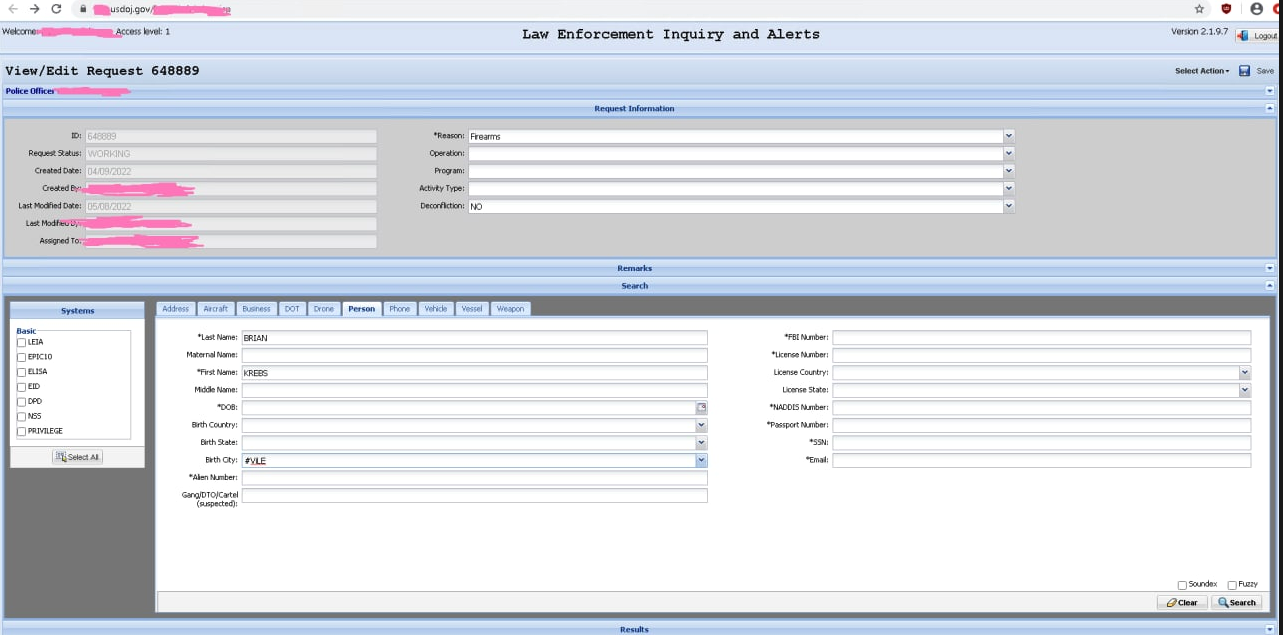
A screenshot of alleged access to the Drug Enforcement Agency’s intelligence sharing portal, shared by “KT,” the current administrator of the doxing and harassment community Doxbin.
The government alleges that on May 7, 2022, Singh used stolen credentials to log into a U.S. federal government portal without authorization. The complaint doesn’t specify which agency portal was hacked, but it does state that the portal included access to law enforcement databases that track narcotics seizures in the United States.
On May 12, 2022, KrebsOnSecurity broke the news that hackers had gained access to a DEA portal that taps into 16 different federal law enforcement databases. As reported at the time, the inside scoop on how that hack went down came from KT, the current administrator of the Doxbin and the individual referenced in the government’s complaint as “CC-1.”
Indeed, a screenshot of the ViLE group website includes the group’s official roster, which lists KT at the top, followed by Weep and Ominus.

A screenshot of the website for the cybercriminal group “ViLE.” Image: USDOJ.
In March 2022, KrebsOnSecurity warned that multiple cybercrime groups were finding success with fraudulent Emergency Data Requests (EDRs), wherein the hackers use compromised police and government email accounts to file warrantless data requests with social media firms and mobile telephony providers, attesting that the information being requested can’t wait for a warrant because it relates to an urgent matter of life and death.
That story showed that the previous owner of the Doxbin also was part of a teenage hacking group that specialized in offering fake EDRs as a service on the dark web.
Prosecutors say they tied Singh to the government portal hack because he connected to it from an Internet address that he’d previously used to access a social media account registered in his name. When they raided Singh’s residence on Sept. 8, 2022 and seized his devices, investigators with Homeland Security found a cellular phone and laptop that allegedly “contained extensive evidence of access to the Portal.”
The complaint alleges that between February 2022 and May 2022, Ceraolo used an official email account belonging to a Bangladeshi police official to pose as a police officer in communication with U.S.-based social media platforms.
“In these communications, Ceraolo requested personal information about users of these platforms, under the false pretense that the users were committing crimes or in life-threatening danger,” the complaint states.
For example, on or about March 13, 2022, Ceraolo allegedly used the Bangladeshi police email account to falsely claim that the target of the EDR had sent bomb threats, distributed child pornography and threatened officials of the Bangladeshi government.
On or about May 9, 2022, the government says, Singh sent a friend screenshots of text messages between himself and someone he had doxed on the Doxbin and was trying to extort for their Instagram handle. The data included the victim’s Social Security number, driver’s license number, cellphone number, and home address.
“Look familiar?” Singh allegedly wrote to the victim. “You’re gonna comply to me if you don’t want anything negative to happen to your parents. . . I have every detail involving your parents . . . allowing me to do whatever I desire to them in malicious ways.”
Neither of the defendants could be immediately reached for comment. KT, the current administrator of Doxbin, declined a request for comment on the charges.
Ceraolo is a self-described security researcher who has been credited in many news stories over the years with discovering security vulnerabilities at AT&T, T-Mobile, Comcast and Cox Communications.
Ceraolo’s stated partner in most of these discoveries — a 30-year-old Connecticut man named Ryan “Phobia” Stevenson — was charged in 2019 with being part of a group that stole millions of dollars worth of cryptocurrencies via SIM-swapping, a crime that involves tricking a mobile provider into routing a target’s calls and text messages to another device.
In 2018, KrebsOnSecurity detailed how Stevenson earned bug bounty rewards and public recognition from top telecom companies for finding and reporting security holes in their websites, all the while secretly peddling those same vulnerabilities to cybercriminals.
According to the Justice Department, if convicted Ceraolo faces up to 20 years’ imprisonment for conspiracy to commit wire fraud; both Ceraolo and Singh face five years’ imprisonment for conspiracy to commit computer intrusions.
A copy of the complaint against Ceraolo and Singh is here (PDF).

Today, we released the latest issue of The Domain Name Industry Brief, which shows that the fourth quarter of 2022 closed with 350.4 million domain name registrations across all top-level domains (TLDs), an increase of 0.5 million domain name registrations, or 0.1%, compared to the third quarter of 2022.1,2 Domain name registrations have increased by 8.7 million, or 2.6%, year over year.1,2
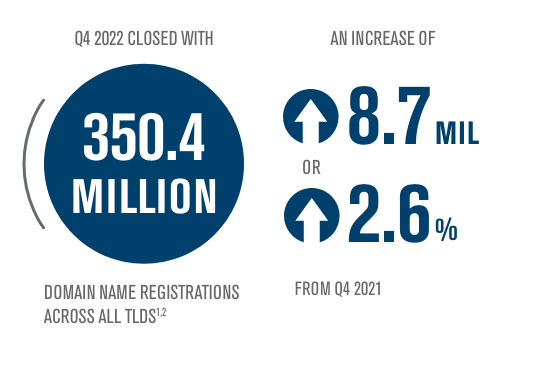
Check out the latest issue of The Domain Name Industry Brief to see domain name stats from the fourth quarter of 2022, including:
• Top 10 Largest TLDs by Number of Reported Domain Names
• Top 10 Largest ccTLDs by Number of Reported Domain Names
• ngTLDs as Percentage of Total TLDs
• Geographical ngTLDs as Percentage of Total Corresponding Geographical TLDs
To see past issues of The Domain Name Industry Brief, please visit https://verisign.com/dnibarchives.
The post Verisign Domain Name Industry Brief: 350.4 Million Domain Name Registrations in the Fourth Quarter of 2022 appeared first on Verisign Blog.
A Croatian national has been arrested for allegedly operating NetWire, a Remote Access Trojan (RAT) marketed on cybercrime forums since 2012 as a stealthy way to spy on infected systems and siphon passwords. The arrest coincided with a seizure of the NetWire sales website by the U.S. Federal Bureau of Investigation (FBI). While the defendant in this case hasn’t yet been named publicly, the NetWire website has been leaking information about the likely true identity and location of its owner for the past 11 years.
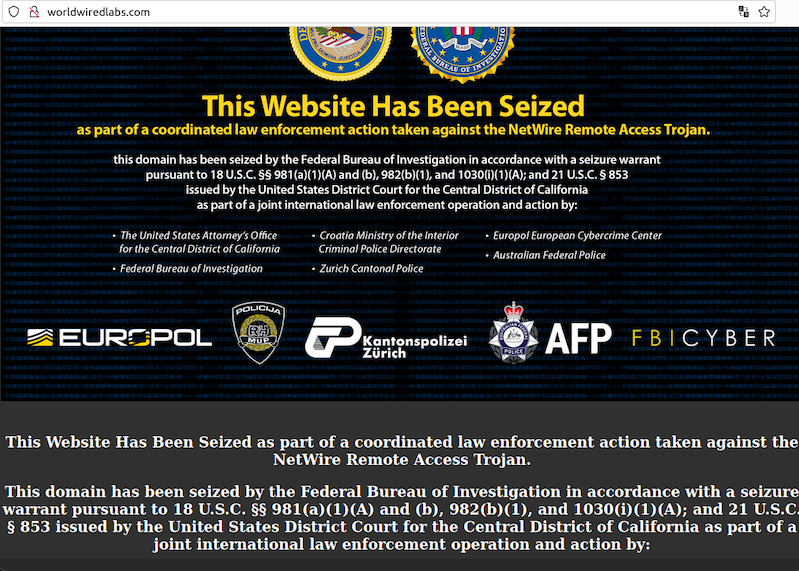
Typically installed by booby-trapped Microsoft Office documents and distributed via email, NetWire is a multi-platform threat that is capable of targeting not only Microsoft Windows machines but also Android, Linux and Mac systems.
NetWire’s reliability and relatively low cost ($80-$140 depending on features) has made it an extremely popular RAT on the cybercrime forums for years, and NetWire infections consistently rank among the top 10 most active RATs in use.
NetWire has been sold openly on the same website since 2012: worldwiredlabs[.]com. That website now features a seizure notice from the U.S. Department of Justice (DOJ), which says the domain was taken as part of “a coordinated law enforcement action taken against the NetWire Remote Access Trojan.”
“As part of this week’s law enforcement action, authorities in Croatia on Tuesday arrested a Croatian national who allegedly was the administrator of the website,” reads a statement by the DOJ today. “This defendant will be prosecuted by Croatian authorities. Additionally, law enforcement in Switzerland on Tuesday seized the computer server hosting the NetWire RAT infrastructure.”
Neither the DOJ’s statement nor a press release on the operation published by Croatian authorities mentioned the name of the accused. But it’s fairly remarkable that it has taken so long for authorities in the United States and elsewhere to move against NetWire and its alleged proprietor, given that the RAT’s author apparently did very little to hide his real-life identity.
The WorldWiredLabs website first came online in February 2012 using a dedicated host with no other domains. The site’s true WHOIS registration records have always been hidden by privacy protection services, but there are plenty of clues in historical Domain Name System (DNS) records for WorldWiredLabs that point in the same direction.
In October 2012, the WorldWiredLabs domain moved to another dedicated server at the Internet address 198.91.90.7, which was home to just one other domain: printschoolmedia[.]org, also registered in 2012.
According to DomainTools.com, printschoolmedia[.]org was registered to a Mario Zanko in Zapresic, Croatia, and to the email address zankomario@gmail.com. DomainTools further shows this email address was used to register one other domain in 2012: wwlabshosting[.]com, also registered to Mario Zanko from Croatia.
A review of DNS records for both printschoolmedia[.]org and wwlabshosting[.]com shows that while these domains were online they both used the DNS name server ns1.worldwiredlabs[.]com. No other domains have been recorded using that same name server.
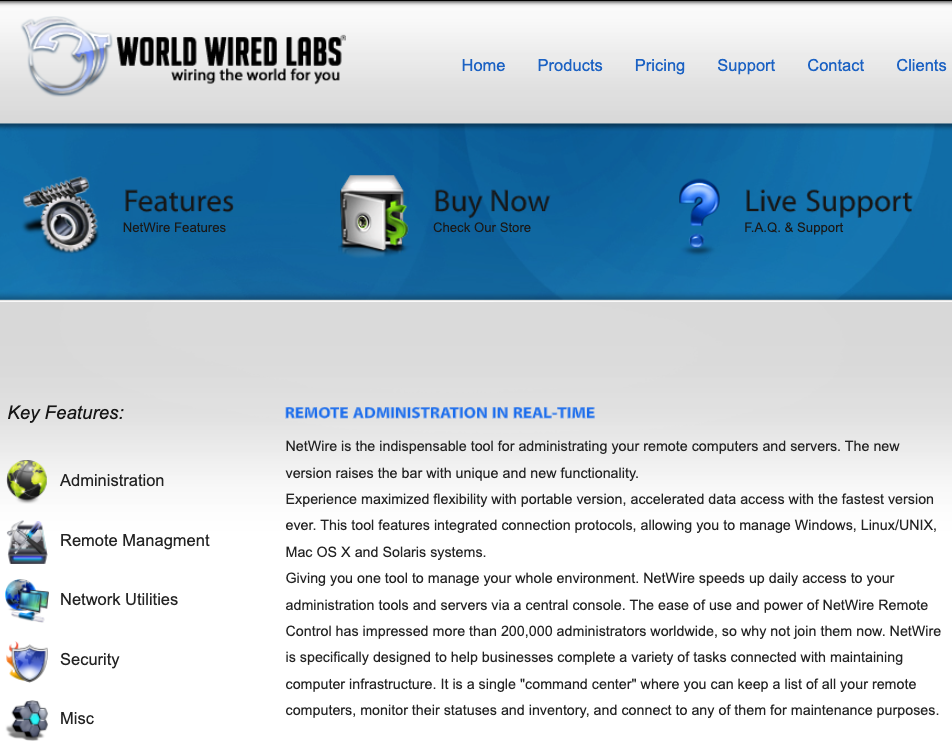
The WorldWiredLabs website, in 2013. Source: Archive.org.
DNS records for worldwiredlabs[.]com also show the site forwarded incoming email to the address tommaloney@ruggedinbox.com. Constella Intelligence, a service that indexes information exposed by public database leaks, shows this email address was used to register an account at the clothing retailer romwe.com, using the password “123456xx.”
Running a reverse search on this password in Constella Intelligence shows there are more than 450 email addresses known to have used this credential, and two of those are zankomario@gmail.com and zankomario@yahoo.com.
A search on zankomario@gmail.com in Skype returns three results, including the account name “Netwire” and the username “Dugidox,” and another for a Mario Zanko (username zanko.mario).
 Dugidox corresponds to the hacker handle most frequently associated with NetWire sales and support discussion threads on multiple cybercrime forums over the years.
Dugidox corresponds to the hacker handle most frequently associated with NetWire sales and support discussion threads on multiple cybercrime forums over the years.
Constella ties dugidox@gmail.com to a number of website registrations, including the Dugidox handle on BlackHatWorld and HackForums, and to IP addresses in Croatia for both. Constella also shows the email address zankomario@gmail.com used the password “dugidox2407.”
In 2010, someone using the email address dugidox@gmail.com registered the domain dugidox[.]com. The WHOIS registration records for that domain list a “Senela Eanko” as the registrant, but the address used was the same street address in Zapresic that appears in the WHOIS records for printschoolmedia[.]org, which is registered in Mr. Zanco’s name.
Prior to the demise of Google+, the email address dugidox@gmail.com mapped to an account with the nickname “Netwire wwl.” The dugidox email also was tied to a Facebook account (mario.zanko3), which featured check-ins and photos from various places in Croatia.
That Facebook profile is no longer active, but back in January 2017, the administrator of WorldWiredLabs posted that he was considering adding certain Android mobile functionality to his service. Three days after that, the Mario.Zank3 profile posted a photo saying he was selected for an Android instruction course — with his dugidox email in the photo, naturally.
Incorporation records from the U.K.’s Companies House show that in 2017 Mr. Zanko became an officer in a company called Godbex Solutions LTD. A Youtube video invoking this corporate name describes Godbex as a “next generation platform” for exchanging gold and cryptocurrencies.
The U.K. Companies House records show Godbex was dissolved in 2020. It also says Mr. Zanko was born in July 1983, and lists his occupation as “electrical engineer.”
Mr. Zanko did not respond to multiple requests for comment.
A statement from the Croatian police about the NetWire takedown is here.
The domain name registrar Freenom, whose free domain names have long been a draw for spammers and phishers, has stopped allowing new domain name registrations. The move comes after the Dutch registrar was sued by Meta, which alleges the company ignores abuse complaints about phishing websites while monetizing traffic to those abusive domains.
Freenom is the domain name registry service provider for five so-called “country code top level domains” (ccTLDs), including .cf for the Central African Republic; .ga for Gabon; .gq for Equatorial Guinea; .ml for Mali; and .tk for Tokelau.
Freenom has always waived the registration fees for domains in these country-code domains, presumably as a way to encourage users to pay for related services, such as registering a .com or .net domain, for which Freenom does charge a fee.
On March 3, 2023, social media giant Meta sued Freenom in a Northern California court, alleging cybersquatting violations and trademark infringement. The lawsuit also seeks information about the identities of 20 different “John Does” — Freenom customers that Meta says have been particularly active in phishing attacks against Facebook, Instagram, and WhatsApp users.
The lawsuit points to a 2021 study (PDF) on the abuse of domains conducted by Interisle Consulting Group, which discovered that those ccTLDs operated by Freenom made up five of the Top Ten TLDs most abused by phishers.
“The five ccTLDs to which Freenom provides its services are the TLDs of choice for cybercriminals because Freenom provides free domain name registration services and shields its customers’ identity, even after being presented with evidence that the domain names are being used for illegal purposes,” the complaint charges. “Even after receiving notices of infringement or phishing by its customers, Freenom continues to license new infringing domain names to those same customers.”
Meta further alleges that “Freenom has repeatedly failed to take appropriate steps to investigate and respond appropriately to reports of abuse,” and that it monetizes the traffic from infringing domains by reselling them and by adding “parking pages” that redirect visitors to other commercial websites, websites with pornographic content, and websites used for malicious activity like phishing.
Freenom has not yet responded to requests for comment. But attempts to register a domain through the company’s website as of publication time generated an error message that reads:
“Because of technical issues the Freenom application for new registrations is temporarily out-of-order. Please accept our apologies for the inconvenience. We are working on a solution and hope to resume operations shortly. Thank you for your understanding.”
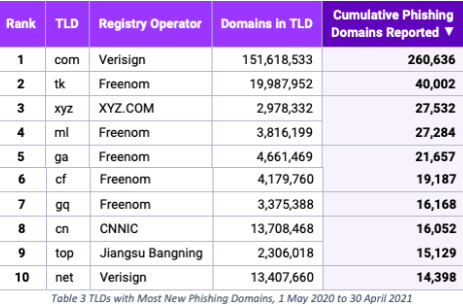
Image: Interisle Consulting Group, Phishing Landscape 2021, Sept. 2021.
Although Freenom is based in The Netherlands, some of its other sister companies named as defendants in the lawsuit are incorporated in the United States.
Meta initially filed this lawsuit in December 2022, but it asked the court to seal the case, which would have restricted public access to court documents in the dispute. That request was denied, and Meta amended and re-filed the lawsuit last week.
According to Meta, this isn’t just a case of another domain name registrar ignoring abuse complaints because it’s bad for business. The lawsuit alleges that the owners of Freenom “are part of a web of companies created to facilitate cybersquatting, all for the benefit of Freenom.”
“On information and belief, one or more of the ccTLD Service Providers, ID Shield, Yoursafe, Freedom Registry, Fintag, Cervesia, VTL, Joost Zuurbier Management Services B.V., and Doe Defendants were created to hide assets, ensure unlawful activity including cybersquatting and phishing goes undetected, and to further the goals of Freenom,” Meta charged.
It remains unclear why Freenom has stopped allowing domain registration. In June 2015, ICANN suspended Freenom’s ability to create new domain names or initiate inbound transfers of domain names for 90 days. According to Meta, the suspension was premised on ICANN’s determination that Freenom “has engaged in a pattern and practice of trafficking in or use of domain names identical or confusingly similar to a trademark or service mark of a third party in which the Registered Name Holder has no rights or legitimate interest.”
A spokesperson for ICANN said the organization has no insight as to why Freenom might have stopped registering domain names. But it said Freenom (d/b/a OpenTLD B.V.) also received formal enforcement notices from ICANN in 2017 and 2020 for violating different obligations.
A copy of the amended complaint against Freenom, et. al, is available here (PDF).
March 8, 6:11 p.m. ET: Updated story with response from ICANN. Corrected attribution of the domain abuse report.
The Biden administration today issued its vision for beefing up the nation’s collective cybersecurity posture, including calls for legislation establishing liability for software products and services that are sold with little regard for security. The White House’s new national cybersecurity strategy also envisions a more active role by cloud providers and the U.S. military in disrupting cybercriminal infrastructure, and it names China as the single biggest cyber threat to U.S. interests.

The strategy says the White House will work with Congress and the private sector to develop legislation that would prevent companies from disavowing responsibility for the security of their software products or services.
Coupled with this stick would be a carrot: An as-yet-undefined “safe harbor framework” that would lay out what these companies could do to demonstrate that they are making cybersecurity a central concern of their design and operations.
“Any such legislation should prevent manufacturers and software publishers with market power from fully disclaiming liability by contract, and establish higher standards of care for software in specific high-risk scenarios,” the strategy explains. “To begin to shape standards of care for secure software development, the Administration will drive the development of an adaptable safe harbor framework to shield from liability companies that securely develop and maintain their software products and services.”
Brian Fox, chief technology officer and founder of the software supply chain security firm Sonatype, called the software liability push a landmark moment for the industry.
“Market forces are leading to a race to the bottom in certain industries, while contract law allows software vendors of all kinds to shield themselves from liability,” Fox said. “Regulations for other industries went through a similar transformation, and we saw a positive result — there’s now an expectation of appropriate due care, and accountability for those who fail to comply. Establishing the concept of safe harbors allows the industry to mature incrementally, leveling up security best practices in order to retain a liability shield, versus calling for sweeping reform and unrealistic outcomes as previous regulatory attempts have.”
In 2012 (approximately three national cyber strategies ago), then director of the U.S. National Security Agency (NSA) Keith Alexander made headlines when he remarked that years of successful cyber espionage campaigns from Chinese state-sponsored hackers represented “the greatest transfer of wealth in history.”
The document released today says the People’s Republic of China (PRC) “now presents the broadest, most active, and most persistent threat to both government and private sector networks,” and says China is “the only country with both the intent to reshape the international order and, increasingly, the economic, diplomatic, military, and technological power to do so.”
Many of the U.S. government’s efforts to restrain China’s technology prowess involve ongoing initiatives like the CHIPS Act, a new law signed by President Biden last year that sets aside more than $50 billion to expand U.S.-based semiconductor manufacturing and research and to make the U.S. less dependent on foreign suppliers; the National Artificial Intelligence Initiative; and the National Strategy to Secure 5G.
As the maker of most consumer gizmos with a computer chip inside, China is also the source of an incredible number of low-cost Internet of Things (IoT) devices that are not only poorly secured, but are probably more accurately described as insecure by design.
The Biden administration said it would continue its previously announced plans to develop a system of labeling that could be applied to various IoT products and give consumers some idea of how secure the products may be. But it remains unclear how those labels might apply to products made by companies outside of the United States.
One could convincingly make the case that the world has witnessed yet another historic transfer of wealth and trade secrets over the past decade — in the form of ransomware and data ransom attacks by Russia-based cybercriminal syndicates, as well as Russian intelligence agency operations like the U.S. government-wide Solar Winds compromise.

On the ransomware front, the White House strategy seems to focus heavily on building the capability to disrupt the digital infrastructure used by adversaries that are threatening vital U.S. cyber interests. The document points to the 2021 takedown of the Emotet botnet — a cybercrime machine that was heavily used by multiple Russian ransomware groups — as a model for this activity, but says those disruptive operations need to happen faster and more often.
To that end, the Biden administration says it will expand the capacity of the National Cyber Investigative Joint Task Force (NCIJTF), the primary federal agency for coordinating cyber threat investigations across law enforcement agencies, the intelligence community, and the Department of Defense.
“To increase the volume and speed of these integrated disruption campaigns, the Federal Government must further develop technological and organizational platforms that enable continuous, coordinated operations,” the strategy observes. “The NCIJTF will expand its capacity to coordinate takedown and disruption campaigns with greater speed, scale, and frequency. Similarly, DoD and the Intelligence Community are committed to bringing to bear their full range of complementary authorities to disruption campaigns.”
The strategy anticipates the U.S. government working more closely with cloud and other Internet infrastructure providers to quickly identify malicious use of U.S.-based infrastructure, share reports of malicious use with the government, and make it easier for victims to report abuse of these systems.
“Given the interest of the cybersecurity community and digital infrastructure owners and operators in continuing this approach, we must sustain and expand upon this model so that collaborative disruption operations can be carried out on a continuous basis,” the strategy argues. “Threat specific collaboration should take the form of nimble, temporary cells, comprised of a small number of trusted operators, hosted and supported by a relevant hub. Using virtual collaboration platforms, members of the cell would share information bidirectionally and work rapidly to disrupt adversaries.”
But here, again, there is a carrot-and-stick approach: The administration said it is taking steps to implement Executive Order (EO) 13984 –issued by the Trump administration in January 2021 — which requires cloud providers to verify the identity of foreign persons using their services.
“All service providers must make reasonable attempts to secure the use of their infrastructure against abuse or other criminal behavior,” the strategy states. “The Administration will prioritize adoption and enforcement of a risk-based approach to cybersecurity across Infrastructure-as-a-Service providers that addresses known methods and indicators of malicious activity including through implementation of EO 13984.”
Ted Schlein, founding partner of the cybersecurity venture capital firm Ballistic Ventures, said how this gets implemented will determine whether it can be effective.
“Adversaries know the NSA, which is the elite portion of the nation’s cyber defense, cannot monitor U.S.-based infrastructure, so they just use U.S.-based cloud infrastructure to perpetrate their attacks,” Schlein said. “We have to fix this. I believe some of this section is a bit pollyannaish, as it assumes a bad actor with a desire to do a bad thing will self-identify themselves, as the major recommendation here is around KYC (‘know your customer’).”
One brief but interesting section of the strategy titled “Explore a Federal Cyber Insurance Backdrop” contemplates the government’s liability and response to a too-big-to-fail scenario or “catastrophic cyber incident.”
“We will explore how the government can stabilize insurance markets against catastrophic risk to drive better cybersecurity practices and to provide market certainty when catastrophic events do occur,” the strategy reads.
When the Bush administration released the first U.S. national cybersecurity strategy 20 years ago after the 9/11 attacks, the popular term for that same scenario was a “digital Pearl Harbor,” and there was a great deal of talk then about how the cyber insurance market would soon help companies shore up their cybersecurity practices.
In the wake of countless ransomware intrusions, many companies now hold cybersecurity insurance to help cover the considerable costs of responding to such intrusions. Leaving aside the question of whether insurance coverage has helped companies improve security, what happens if every one of these companies has to make a claim at the same time?
The notion of a Digital Pearl Harbor incident struck many experts at the time as a hyperbolic justification for expanding the government’s digital surveillance capabilities, and an overstatement of the capabilities of our adversaries. But back in 2003, most of the world’s companies didn’t host their entire business in the cloud.
Today, nobody questions the capabilities, goals and outcomes of dozens of nation-state level cyber adversaries. And these days, a catastrophic cyber incident could be little more than an extended, simultaneous outage at multiple cloud providers.
The full national cybersecurity strategy is available from the White House website (PDF).

Image: Shutterstock.com
Three different cybercriminal groups claimed access to internal networks at communications giant T-Mobile in more than 100 separate incidents throughout 2022, new data suggests. In each case, the goal of the attackers was the same: Phish T-Mobile employees for access to internal company tools, and then convert that access into a cybercrime service that could be hired to divert any T-Mobile user’s text messages and phone calls to another device.
The conclusions above are based on an extensive analysis of Telegram chat logs from three distinct cybercrime groups or actors that have been identified by security researchers as particularly active in and effective at “SIM-swapping,” which involves temporarily seizing control over a target’s mobile phone number.
Countless websites and online services use SMS text messages for both password resets and multi-factor authentication. This means that stealing someone’s phone number often can let cybercriminals hijack the target’s entire digital life in short order — including access to any financial, email and social media accounts tied to that phone number.
All three SIM-swapping entities that were tracked for this story remain active in 2023, and they all conduct business in open channels on the instant messaging platform Telegram. KrebsOnSecurity is not naming those channels or groups here because they will simply migrate to more private servers if exposed publicly, and for now those servers remain a useful source of intelligence about their activities.
Each advertises their claimed access to T-Mobile systems in a similar way. At a minimum, every SIM-swapping opportunity is announced with a brief “Tmobile up!” or “Tmo up!” message to channel participants. Other information in the announcements includes the price for a single SIM-swap request, and the handle of the person who takes the payment and information about the targeted subscriber.
The information required from the customer of the SIM-swapping service includes the target’s phone number, and the serial number tied to the new SIM card that will be used to receive text messages and phone calls from the hijacked phone number.
Initially, the goal of this project was to count how many times each entity claimed access to T-Mobile throughout 2022, by cataloging the various “Tmo up!” posts from each day and working backwards from Dec. 31, 2022.
But by the time we got to claims made in the middle of May 2022, completing the rest of the year’s timeline seemed unnecessary. The tally shows that in the last seven-and-a-half months of 2022, these groups collectively made SIM-swapping claims against T-Mobile on 104 separate days — often with multiple groups claiming access on the same days.
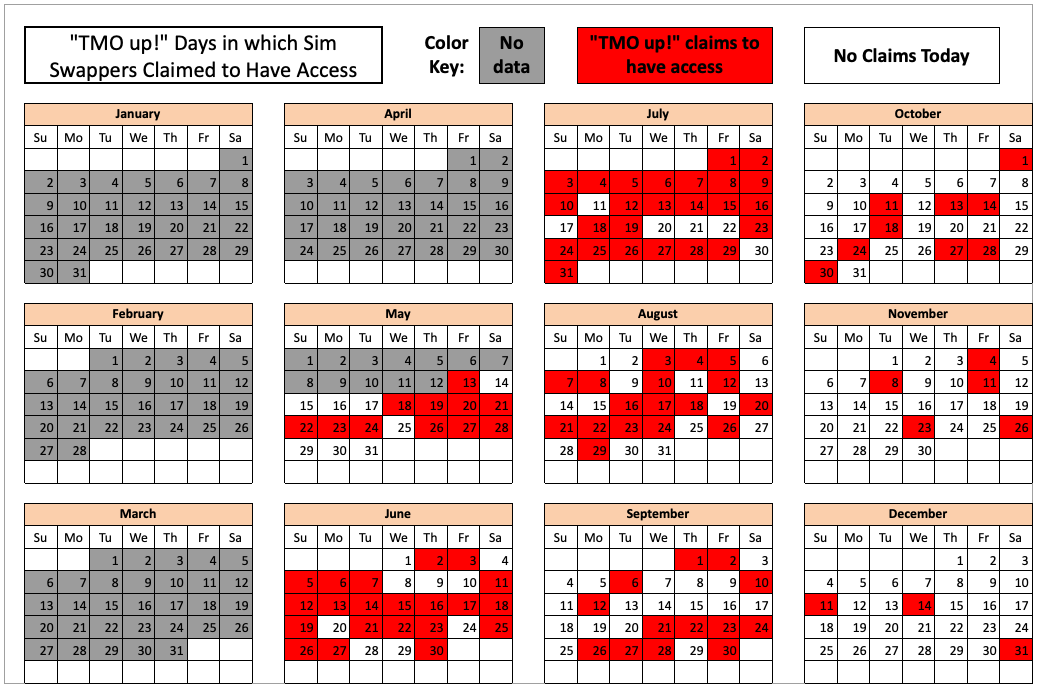
The 104 days in the latter half of 2022 in which different known SIM-swapping groups claimed access to T-Mobile employee tools.
KrebsOnSecurity shared a large amount of data gathered for this story with T-Mobile. The company declined to confirm or deny any of these claimed intrusions. But in a written statement, T-Mobile said this type of activity affects the entire wireless industry.
“And we are constantly working to fight against it,” the statement reads. “We have continued to drive enhancements that further protect against unauthorized access, including enhancing multi-factor authentication controls, hardening environments, limiting access to data, apps or services, and more. We are also focused on gathering threat intelligence data, like what you have shared, to help further strengthen these ongoing efforts.”
While it is true that each of these cybercriminal actors periodically offer SIM-swapping services for other mobile phone providers — including AT&T, Verizon and smaller carriers — those solicitations appear far less frequently in these group chats than T-Mobile swap offers. And when those offers do materialize, they are considerably more expensive.
The prices advertised for a SIM-swap against T-Mobile customers in the latter half of 2022 ranged between USD $1,000 and $1,500, while SIM-swaps offered against AT&T and Verizon customers often cost well more than twice that amount.

To be clear, KrebsOnSecurity is not aware of specific SIM-swapping incidents tied to any of these breach claims. However, the vast majority of advertisements for SIM-swapping claims against T-Mobile tracked in this story had two things in common that set them apart from random SIM-swapping ads on Telegram.
First, they included an offer to use a mutually trusted “middleman” or escrow provider for the transaction (to protect either party from getting scammed). More importantly, the cybercriminal handles that were posting ads for SIM-swapping opportunities from these groups generally did so on a daily or near-daily basis — often teasing their upcoming swap events in the hours before posting a “Tmo up!” message announcement.
In other words, if the crooks offering these SIM-swapping services were ripping off their customers or claiming to have access that they didn’t, this would be almost immediately obvious from the responses of the more seasoned and serious cybercriminals in the same chat channel.
There are plenty of people on Telegram claiming to have SIM-swap access at major telecommunications firms, but a great many such offers are simply four-figure scams, and any pretenders on this front are soon identified and banned (if not worse).
One of the groups that reliably posted “Tmo up!” messages to announce SIM-swap availability against T-Mobile customers also reliably posted “Tmo down!” follow-up messages announcing exactly when their claimed access to T-Mobile employee tools was discovered and revoked by the mobile giant.
A review of the timestamps associated with this group’s incessant “Tmo up” and “Tmo down” posts indicates that while their claimed access to employee tools usually lasted less than an hour, in some cases that access apparently went undiscovered for several hours or even days.
How could these SIM-swapping groups be gaining access to T-Mobile’s network as frequently as they claim? Peppered throughout the daily chit-chat on their Telegram channels are solicitations for people urgently needed to serve as “callers,” or those who can be hired to social engineer employees over the phone into navigating to a phishing website and entering their employee credentials.
Allison Nixon is chief research officer for the New York City-based cybersecurity firm Unit 221B. Nixon said these SIM-swapping groups will typically call employees on their mobile devices, pretend to be someone from the company’s IT department, and then try to get the person on the other end of the line to visit a phishing website that mimics the company’s employee login page.
Nixon argues that many people in the security community tend to discount the threat from voice phishing attacks as somehow “low tech” and “low probability” threats.
“I see it as not low-tech at all, because there are a lot of moving parts to phishing these days,” Nixon said. “You have the caller who has the employee on the line, and the person operating the phish kit who needs to spin it up and down fast enough so that it doesn’t get flagged by security companies. Then they have to get the employee on that phishing site and steal their credentials.”
In addition, she said, often there will be yet another co-conspirator whose job it is to use the stolen credentials and log into employee tools. That person may also need to figure out how to make their device pass “posture checks,” a form of device authentication that some companies use to verify that each login is coming only from employer-issued phones or laptops.
For aspiring criminals with little experience in scam calling, there are plenty of sample call transcripts available on these Telegram chat channels that walk one through how to impersonate an IT technician at the targeted company — and how to respond to pushback or skepticism from the employee. Here’s a snippet from one such tutorial that appeared recently in one of the SIM-swapping channels:
“Hello this is James calling from Metro IT department, how’s your day today?”
(yea im doing good, how r u)
i’m doing great, thank you for asking
i’m calling in regards to a ticket we got last week from you guys, saying you guys were having issues with the network connectivity which also interfered with [Microsoft] Edge, not letting you sign in or disconnecting you randomly. We haven’t received any updates to this ticket ever since it was created so that’s why I’m calling in just to see if there’s still an issue or not….”
The TMO UP data referenced above, combined with comments from the SIM-swappers themselves, indicate that while many of their claimed accesses to T-Mobile tools in the middle of 2022 lasted hours on end, both the frequency and duration of these events began to steadily decrease as the year wore on.

T-Mobile declined to discuss what it may have done to combat these apparent intrusions last year. However, one of the groups began to complain loudly in late October 2022 that T-Mobile must have been doing something that was causing their phished access to employee tools to die very soon after they obtained it.
One group even remarked that they suspected T-Mobile’s security team had begun monitoring their chats.
Indeed, the timestamps associated with one group’s TMO UP/TMO DOWN notices show that their claimed access was often limited to less than 15 minutes throughout November and December of 2022.
Whatever the reason, the calendar graphic above clearly shows that the frequency of claimed access to T-Mobile decreased significantly across all three SIM-swapping groups in the waning weeks of 2022.
T-Mobile US reported revenues of nearly $80 billion last year. It currently employs more than 71,000 people in the United States, any one of whom can be a target for these phishers.
T-Mobile declined to answer questions about what it may be doing to beef up employee authentication. But Nicholas Weaver, a researcher and lecturer at University of California, Berkeley’s International Computer Science Institute, said T-Mobile and all the major wireless providers should be requiring employees to use physical security keys for that second factor when logging into company resources.

A U2F device made by Yubikey.
“These breaches should not happen,” Weaver said. “Because T-Mobile should have long ago issued all employees security keys and switched to security keys for the second factor. And because security keys provably block this style of attack.”
The most commonly used security keys are inexpensive USB-based devices. A security key implements a form of multi-factor authentication known as Universal 2nd Factor (U2F), which allows the user to complete the login process simply by inserting the USB key and pressing a button on the device. The key works without the need for any special software drivers.
The allure of U2F devices for multi-factor authentication is that even if an employee who has enrolled a security key for authentication tries to log in at an impostor site, the company’s systems simply refuse to request the security key if the user isn’t on their employer’s legitimate website, and the login attempt fails. Thus, the second factor cannot be phished, either over the phone or Internet.
Nixon said one confounding aspect of SIM-swapping is that these criminal groups tend to recruit teenagers to do their dirty work.
“A huge reason this problem has been allowed to spiral out of control is because children play such a prominent role in this form of breach,” Nixon said.
Nixon said SIM-swapping groups often advertise low-level jobs on places like Roblox and Minecraft, online games that are extremely popular with young adolescent males.
“Statistically speaking, that kind of recruiting is going to produce a lot of people who are underage,” she said. “They recruit children because they’re naive, you can get more out of them, and they have legal protections that other people over 18 don’t have.”
For example, she said, even when underage SIM-swappers are arrested, the offenders tend to go right back to committing the same crimes as soon as they’re released.
In January 2023, T-Mobile disclosed that a “bad actor” stole records on roughly 37 million current customers, including their name, billing address, email, phone number, date of birth, and T-Mobile account number.
In August 2021, T-Mobile acknowledged that hackers made off with the names, dates of birth, Social Security numbers and driver’s license/ID information on more than 40 million current, former or prospective customers who applied for credit with the company. That breach came to light after a hacker began selling the records on a cybercrime forum.
In the shadow of such mega-breaches, any damage from the continuous attacks by these SIM-swapping groups can seem insignificant by comparison. But Nixon says it’s a mistake to dismiss SIM-swapping as a low volume problem.
“Logistically, you may only be able to get a few dozen or a hundred SIM-swaps in a day, but you can pick any customer you want across their entire customer base,” she said. “Just because a targeted account takeover is low volume doesn’t mean it’s low risk. These guys have crews that go and identify people who are high net worth individuals and who have a lot to lose.”
Nixon said another aspect of SIM-swapping that causes cybersecurity defenders to dismiss the threat from these groups is the perception that they are full of low-skilled “script kiddies,” a derisive term used to describe novice hackers who rely mainly on point-and-click hacking tools.
“They underestimate these actors and say this person isn’t technically sophisticated,” she said. “But if you’re rolling around in millions worth of stolen crypto currency, you can buy that sophistication. I know for a fact some of these compromises were at the hands of these ‘script kiddies,’ but they’re not ripping off other people’s scripts so much as hiring people to make scripts for them. And they don’t care what gets the job done, as long as they get to steal the money.”
Web hosting giant GoDaddy made headlines this month when it disclosed that a multi-year breach allowed intruders to steal company source code, siphon customer and employee login credentials, and foist malware on customer websites. Media coverage understandably focused on GoDaddy’s admission that it suffered three different cyberattacks over as many years at the hands of the same hacking group. But it’s worth revisiting how this group typically got in to targeted companies: By calling employees and tricking them into navigating to a phishing website.

In a filing with the U.S. Securities and Exchange Commission (SEC), GoDaddy said it determined that the same “sophisticated threat actor group” was responsible for three separate intrusions, including:
-March 2020: A spear-phishing attack on a GoDaddy employee compromised the hosting login credentials of approximately 28,000 GoDaddy customers, as well as login credentials for a small number employees;
-November 2021: A compromised GoDaddy password let attackers steal source code and information tied to 1.2 million customers, including website administrator passwords, sFTP credentials, and private SSL keys;
-December 2022: Hackers gained access to and installed malware on GoDaddy’s cPanel hosting servers that “intermittently redirected random customer websites to malicious sites.”
“Based on our investigation, we believe these incidents are part of a multi-year campaign by a sophisticated threat actor group that, among other things, installed malware on our systems and obtained pieces of code related to some services within GoDaddy,” the company stated in its SEC filing.
What else do we know about the cause of these incidents? We don’t know much about the source of the November 2021 incident, other than GoDaddy’s statement that it involved a compromised password, and that it took about two months for the company to detect the intrusion. GoDaddy has not disclosed the source of the breach in December 2022 that led to malware on some customer websites.
But we do know the March 2020 attack was precipitated by a spear-phishing attack against a GoDaddy employee. GoDaddy described the incident at the time in general terms as a social engineering attack, but one of its customers affected by that March 2020 breach actually spoke to one of the hackers involved.
The hackers were able to change the Domain Name System (DNS) records for the transaction brokering site escrow.com so that it pointed to an address in Malaysia that was host to just a few other domains, including the then brand-new phishing domain servicenow-godaddy[.]com.
The general manager of Escrow.com found himself on the phone with one of the GoDaddy hackers, after someone who claimed they worked at GoDaddy called and said they needed him to authorize some changes to the account.
In reality, the caller had just tricked a GoDaddy employee into giving away their credentials, and he could see from the employee’s account that Escrow.com required a specific security procedure to complete a domain transfer.
The general manager of Escrow.com said he suspected the call was a scam, but decided to play along for about an hour — all the while recording the call and coaxing information out of the scammer.
“This guy had access to the notes, and knew the number to call,” to make changes to the account, the CEO of Escrow.com told KrebsOnSecurity. “He was literally reading off the tickets to the notes of the admin panel inside GoDaddy.”
About halfway through this conversation — after being called out by the general manager as an imposter — the hacker admitted that he was not a GoDaddy employee, and that he was in fact part of a group that enjoyed repeated success with social engineering employees at targeted companies over the phone.
Absent from GoDaddy’s SEC statement is another spate of attacks in November 2020, in which unknown intruders redirected email and web traffic for multiple cryptocurrency services that used GoDaddy in some capacity.
It is possible this incident was not mentioned because it was the work of yet another group of intruders. But in response to questions from KrebsOnSecurity at the time, GoDaddy said that incident also stemmed from a “limited” number of GoDaddy employees falling for a sophisticated social engineering scam.
“As threat actors become increasingly sophisticated and aggressive in their attacks, we are constantly educating employees about new tactics that might be used against them and adopting new security measures to prevent future attacks,” GoDaddy said in a written statement back in 2020.
Voice phishing or “vishing” attacks typically target employees who work remotely. The phishers will usually claim that they’re calling from the employer’s IT department, supposedly to help troubleshoot some issue. The goal is to convince the target to enter their credentials at a website set up by the attackers that mimics the organization’s corporate email or VPN portal.
Experts interviewed for an August 2020 story on a steep rise in successful voice phishing attacks said there are generally at least two people involved in each vishing scam: One who is social engineering the target over the phone, and another co-conspirator who takes any credentials entered at the phishing page — including multi-factor authentication codes shared by the victim — and quickly uses them to log in to the company’s website.
The attackers are usually careful to do nothing with the phishing domain until they are ready to initiate a vishing call to a potential victim. And when the attack or call is complete, they disable the website tied to the domain.
This is key because many domain registrars will only respond to external requests to take down a phishing website if the site is live at the time of the abuse complaint. This tactic also can stymie efforts by companies that focus on identifying newly-registered phishing domains before they can be used for fraud.

A U2F device made by Yubikey.
GoDaddy’s latest SEC filing indicates the company had nearly 7,000 employees as of December 2022. In addition, GoDaddy contracts with another 3,000 people who work full-time for the company via business process outsourcing companies based primarily in India, the Philippines and Colombia.
Many companies now require employees to supply a one-time password — such as one sent via SMS or produced by a mobile authenticator app — in addition to their username and password when logging in to company assets online. But both SMS and app-based codes can be undermined by phishing attacks that simply request this information in addition to the user’s password.
One multifactor option — physical security keys — appears to be immune to these advanced scams. The most commonly used security keys are inexpensive USB-based devices. A security key implements a form of multi-factor authentication known as Universal 2nd Factor (U2F), which allows the user to complete the login process simply by inserting the USB device and pressing a button on the device. The key works without the need for any special software drivers.
The allure of U2F devices for multi-factor authentication is that even if an employee who has enrolled a security key for authentication tries to log in at an impostor site, the company’s systems simply refuse to request the security key if the user isn’t on their employer’s legitimate website, and the login attempt fails. Thus, the second factor cannot be phished, either over the phone or Internet.
In July 2018, Google disclosed that it had not had any of its 85,000+ employees successfully phished on their work-related accounts since early 2017, when it began requiring all employees to use physical security keys in place of one-time codes.
A security firm has discovered that a six-year-old crafty botnet known as Mylobot appears to be powering a residential proxy service called BHProxies, which offers paying customers the ability to route their web traffic anonymously through compromised computers. Here’s a closer look at Mylobot, and a deep dive into who may be responsible for operating the BHProxies service.

The BHProxies website.
First identified in 2017 by the security firm Deep Instinct, Mylobot employs a number of fairly sophisticated methods to remain undetected on infected hosts, such as running exclusively in the computer’s temporary memory, and waiting 14 days before attempting to contact the botnet’s command and control servers.
Last year, researchers at Minerva Labs spotted the botnet being used to blast out sextortion scams. But according to a new report from BitSight, the Mylobot botnet’s main functionality has always been about transforming the infected system into a proxy.
The Mylobot malware includes more than 1,000 hard-coded and encrypted domain names, any one of which can be registered and used as control networks for the infected hosts. BitSight researchers found significant overlap in the Internet addresses used by those domains and a domain called BHproxies[.]com.
BHProxies sells access to “residential proxy” networks, which allow someone to rent a residential IP address to use as a relay for their Internet communications, providing anonymity and the advantage of being perceived as a residential user surfing the web. The service is currently advertising access to more than 150,000 devices globally.
“At this point, we cannot prove that BHProxies is linked to Mylobot, but we have a strong suspicion,” wrote BitSight’s Stanislas Arnoud.
To test their hypothesis, BitSight obtained 50 proxies from BHProxies. The researchers were able to use 48 of those 50 proxies to browse to a website they controlled — allowing them to record the true IP addresses of each proxy device.
“Among these 48 recovered residential proxies IP addresses, 28 (58.3%) of those were already present in our sinkhole systems, associated with the Mylobot malware family,” Arnoud continued. “This number is probably higher, but we don’t have a full visibility of the botnet. This gave us clear evidence that Mylobot infected computers are used by the BHProxies service.”
BitSight said it is currently seeing more than 50,000 unique Mylobot infected systems every day, and that India appears to be the most targeted country, followed by the United States, Indonesia and Iran.
“We believe we are only seeing part of the full botnet, which may lead to more than 150,000 infected computers as advertised by BHProxies’ operators,” Arnoud wrote.
The website BHProxies[.]com has been advertised for nearly a decade on the forum Black Hat World by the user BHProxies. BHProxies has authored 129 posts on Black Hat World since 2012, and their last post on the forum was in December 2022.
BHProxies initially was fairly active on Black Hat World between May and November 2012, after which it suddenly ceased all activity. The account didn’t resume posting on the forum until April 2014.
According to cyber intelligence firm Intel 471, the user BHProxies also used the handle “hassan_isabad_subar” and marketed various software tools, including “Subar’s free email creator” and “Subar’s free proxy scraper.”
Intel 471’s data shows that hassan_isabad_subar registered on the forum using the email address jesus.fn.christ@gmail.com. In a June 2012 private message exchange with a website developer on Black Hat World, hassan_isabad_subar confided that they were working at the time to develop two websites, including the now-defunct customscrabblejewelry.com.
DomainTools.com reports that customscrabblejewelry.com was registered in 2012 to a Teresa Shotliff in Chesterland, Ohio. A search on jesus.fn.christ@gmail.com at Constella Intelligence, a company that tracks compromised databases, shows this email address is tied to an account at the fundraising platform omaze.com, for a Brian Shotliff from Chesterland, Ohio.
Reached via LinkedIn, Mr. Shotliff said he sold his BHProxies account to another Black Hat World forum user from Egypt back in 2014. Shotliff shared an April 2014 password reset email from Black Hat World, which shows he forwarded the plaintext password to the email address legendboy2050@yahoo.com. He also shared a PayPal receipt and snippets of Facebook Messenger logs showing conversations in March 2014 with legendboy2050@yahoo.com.
Constella Intelligence confirmed that legendboy2050@yahoo.com was indeed another email address tied to the hassan_isabad_subar/BHProxies identity on Black Hat World. Constella also connects legendboy2050 to Facebook and Instagram accounts for one Abdala Tawfik from Cairo. This user’s Facebook page says Tawfik also uses the name Abdalla Khafagy.
Tawfik’s Instagram account says he is a former operations manager at the social media network TikTok, as well as a former director at Crypto.com.
Abdalla Khafagy’s LinkedIn profile says he was “global director of community” at Crypto.com for about a year ending in January 2022. Before that, the resume says he was operations manager of TikTok’s Middle East and North Africa region for approximately seven months ending in April 2020.
Khafagy’s LinkedIn profile says he is currently founder of LewkLabs, a Dubai-based “blockchain-powered, SocialFi content monetization platform” that last year reported funding of $3.26 million from private investors.
The only experience listed for Khafagy prior to the TikTok job is labeled “Marketing” at “Confidential,” from February 2014 to October 2019.
Reached via LinkedIn, Mr. Khafagy told KrebsOnSecurity that he had a Black Hat World account at some point, but that he didn’t recall ever having used an account by the name BHProxies or hassan_isabad_subar. Khafagy said he couldn’t remember the name of the account he had on the forum.
“I had an account that was simply hacked from me shortly after and I never bothered about it because it wasn’t mine in the first place,” he explained.
Khafagy declined to elaborate on the five-year stint in his resume marked “Confidential.” When asked directly whether he had ever been associated with the BHProxies service, Mr. Khafagy said no.
That Confidential job listing is interesting because its start date lines up with the creation of BHproxies[.]com. Archive.org indexed its first copy of BHProxies[.]com on Mar. 5, 2014, but historic DNS records show BHproxies[.]com first came online Feb. 25, 2014.
Shortly after that conversation with Mr. Khafagy, Mr. Shotliff shared a Facebook/Meta message he received that indicated Mr. Khafagy wanted him to support the claim that the BHProxies account had somehow gone missing.
“Hey mate, it’s been a long time. Hope you are doing well. Someone from Krebs on Security reached out to me about the account I got from you on BHW,” Khafagy’s Meta account wrote. “Didn’t we try to retrieve this account? I remember mentioning to you that it got stolen and I was never able to retrieve it.”
Mr. Shotliff said Khafagy’s sudden message this week was the first time he’d heard that claim.
“He bought the account,” Shotliff said. “He might have lost the account or had it stolen, but it’s not something I remember.”
If you liked this story, you may also enjoy these other investigations into botnet-based proxy services:
A Deep Dive Into the Residential Proxy Service ‘911’
911 Proxy Service Implodes After Disclosing Breach
Meet the Administrators of the RSOCKS Proxy Botnet
The Link Between AWM Proxy & the Glupteba Botnet
15-Year-Old Malware Proxy Network VIP72 Goes Dark
Who’s Behind the TDSS Botnet?










